

12 Native Plants to Know and Grow
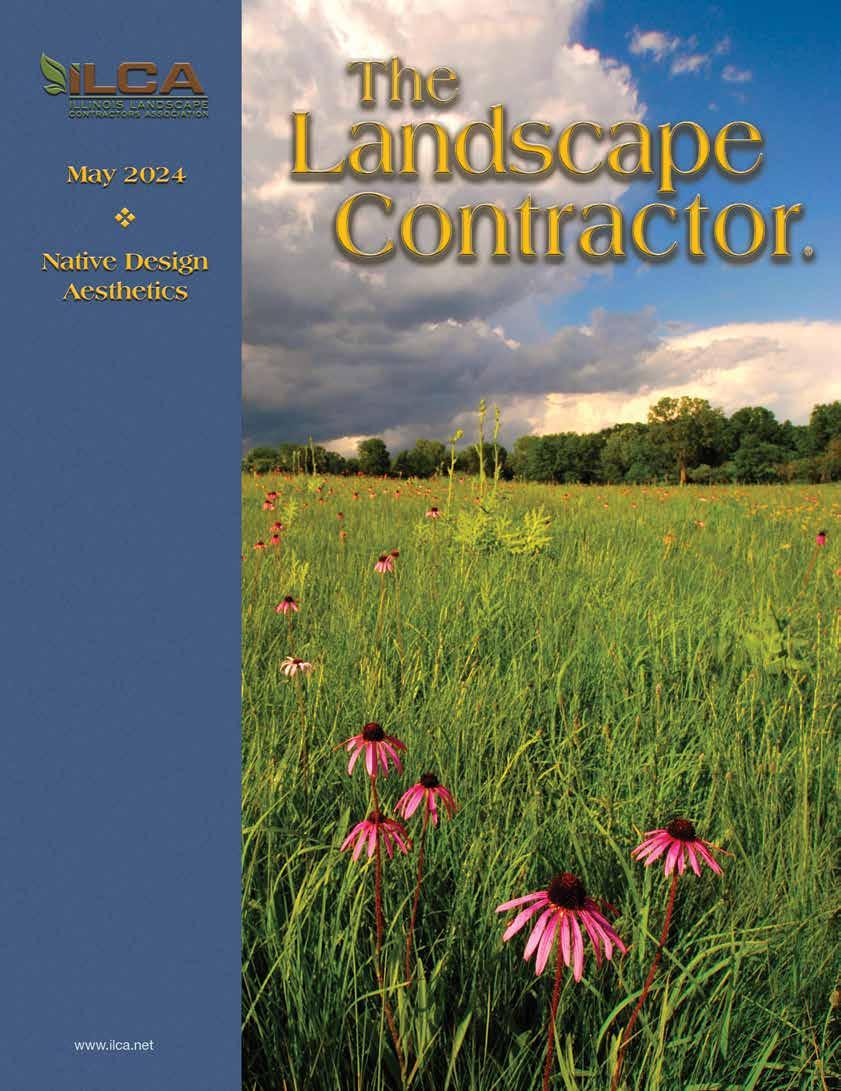 Bloom Time
Bloom Time


CONTACT OUR SALES TEAM: P: 847-742-1790 MGSALES@MIDWESTGROUNDCOVERS.COM WWW.MIDWESTGROUNDCOVERS.COM Place Your Orders at MidwestGroundcovers.com Today! Welcome to midwestgroundcovers.com. We’ll take your orders now.
your
individually,
you’re ready. NEW
FEATURE Save multiple carts in your Customer Portal.
Place
orders
when
WEB
Add or modify carts until you’re ready to submit your order.
Agastache ‘Blue Fortune’


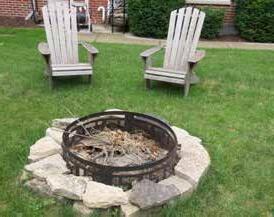

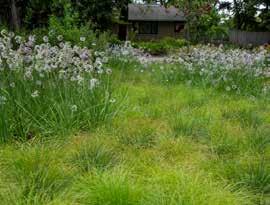
CONTENTS 30 38 May 2024 10 22 The Landscape Contractor May 2024 EN ESPAÑOL Demanda de hierbas de estación cálida en primavera 42 Excellence In Landscape Awards Project 8 FOCUS: Native Design Aesthetics Bloom Time 10 England comes to iLandscape Spring Demand for Warm-Season Grasses 16 A grower’s dilemma Evolution of the Fire Pit 22 Mark Dwyer offers his perspective Professionals’ Choice Award 2024 30 Nature’s Perspective Landscaping gets the prize Native Garden Design — Principles for Success 38 Christa Orum-Keller offers practical solutions Spring Demand for Warm-Season Grasses 12 Native Plants to Know and Grow 50 Drawn from the Palette of Dave Neu Member Profile 52 Frese Ornamental Nursery and Landscaping Inspiration Alley 61 Add some bubbly Before You Go 62 ‘Color Guard’ Yucca 3

Photo Credits
ILCA Awards Committee 1, 8-9
Adrian Bloom 11-14
Mark Dwyer 22-28, 6 2
Perspective Landscaping 30-36
Groundcovers 38-41 NatureSpace LLC 46-55
The official publication of the Illinois Landscape Contractors Association (ILCA), The Landscape Contractor is dedicated to educating, advising and informing members of this industry and furthering the goals of the Association. The Landscape Contractor carries news and features relating to landscape contracting, maintenance, design and allied interests. Publisher is not responsible for unsolicited material and reserves the right to edit any article or advertisement submitted for publication. Publication reserves right to refuse advertising not in keeping with goals of Association. www.ilca.net
Volume 65, Number 5. The Landscape Contractor (ISSN # 0194-7257, USPS # 476-490) is published monthly for $75.00 per year by the Illinois Landscape Contractors Association, 2625 Butterfield Road, Ste. 104S, Oak Brook, IL 60523. Periodicals postage paid at Oak Brook, IL and additional mailing offices. Printed in USA.
POSTMASTER: Send address changes to The Landscape Contractor, 2625 Butterfield Road, Ste 104S, Oak Brook, IL 60523. DISPLAY ADVERTISING SALES: Association Publishing Partners, Inc., Ph. (630) 637-8632 Fax (630) 637-8629 email: rmgi@comcast.net CLASSIFIED ADS, CIRCULATION AND SUBSCRIPTION: ILCA (630) 472-2851 Fax (630) 472-3150 PUBLISHER/EDITORIAL OFFICE: Rick Reuland, rmgi@comcast.net, Naperville, IL 60540 Ph. (630) 637-8632
ILCA Staff
Executive Director
Scott Grams (630) 472-2851 sgrams@ilca.net
Statewide Director of Development Kellie Schmidt kschmidt@ilca.net
Director of Events AnneMarie Drufke adrufke@ilca.net
Edcation Manager Melissa Custic mcustic@ilca.net
Office Manager Alycia Nagy anagy@ilca.net
Membership & Marketing Manager
Marissa Stubler mstubler@ilca.net
2625 Butterfield Road Ste. 104S Oak Brook, IL 60523 (630) 472-2851 • Fax (630) 472-3150 www.ilca.net

Magazine Staff
Rick Reuland
Publisher/Advertising Sales (630) 637-8632 rmgi@comcast.net
Debbie Rauen Advertising Sales (817-501-2403) debbie.landscapecontractor@ yahoo.com v
Meta Levin Feature Writer meta.levin@comcast.net
Nina Koziol Feature Writer n.koziol@att.net
Heather Prince Feature Writer princeht@sbcglobal.net
Patrice Peltier Feature Writer patpeltier@charter.net
Becke Davis EditorialAssistant



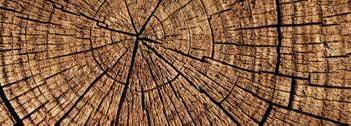

Save the Date! August 8, 2024 The Morton Arboretum Lisle, IL
Nature’s
CONTENTS DEPARTMENTS ILCA Calendar 4 From Where I Stand 5 President’s Message 7 Classified Ads 58 Advertisers Index 61 PRODUCT DISCLAIMER: The Illinois Landscape Contractors Association, its Board of Directors, the Magazine Committee, ILCA Staff, The Landscape Contractor and its staff, neither endorse any products nor attest to the validity of any statements made about products
Midwest
v
ILCA
@ILCAlandscape facebook.com/illinoislandscapecontractorsassociation MAPLE PARK 45W121 Beith Road Maple Park, IL 60151 HUNTLEY 14029 Church Road Huntley, IL 60142 Let us make your landscape shopping easier and installations more successful! our offerings SHADE TREES • ORNAMENTALS EVERGREENS • SHRUBS sales@dotynurseries.com P 630 365 9063
Frese Ornamental Nursery and Landscaping 5 6-57 Nina Koziol 61
The Landscape Contractor May 2024 4 Follow—
If locusts are ravenous sociopaths, cicadas are more like frat boys - clumsy, loud, and obsessed with sex.
Catherine Price, author
In order to be considered a true Illinoisan you have to pass certain tests. You need to have survived at least one blizzard and can name the year. You must believe that Michael Jordan is the GOAT and anyone who mentions the name LeBron James should be dropped at the Indiana state line. You can sing the chorus to The Super Bowl Shuffle. You can name at least 2 previously incarcerated governors. You know your Portillo’s order by heart. You have seen the likeness of Abraham Lincoln so many times you know what cheek his mole is on.
There is one more tie that binds all Illinoisans - you have survived a 17-year cicada brood (Brood XIII). It is hard to describe a cicada brood to the uninitiated. This will be only my third cicada brood XIII. Some of us have seen four, some of us five, very few of us are lucky enough to make six. Illinois’ second largest brood are the 13-year cicadas (Brood XIX). In 2024, for the first time since 1803, both broods will emerge in the exact same year.
From Where I Stand — Super Fly

climb the nearest tree, fence, Purdue basketball center, or other tall surface. They will shed their exoskeleton (their exuvia) which are the perfect copy of the nymph. Once males crack out of those shells – it’s party time. With newfound wings, they take to the trees to sing like one giant boy band trying to attract mates. The trees in the summer come alive with a deafening caterwauling of cicada singing. That loud and constant singing draws females to the tree. Due to The Landscape Contractor being a family magazine - what happens next has been redacted.
The pregnant females retreat to lower, smaller branches and cut small slits in order to lay their eggs. The male cicadas just go and die with big grins on their faces. Eventually, the females die, too. The nymphs fall or crawl to the ground and burrow back into the soilnot to be seen for another 17 years.
The small slits are the biggest danger cicadas pose to our landscapes. That is why netting or tulle is advised for recently planted trees or shrubs. Most female cicadas prefer branches about the size of a pencil. Plant material in the small section of Central Illinois where the broods crossover is probably at the highest risk of damage. Due to the sheer number of preggo females, there can be damage to whips and supple plant material across the region.
You know when an event is in Roman Numerals, it’s got to be a big deal. Only Super Bowls, the Olympic Games, and the tenth Fast and Furious movie receive that rare honor. Sure, it is confusing that the 17-year is Brood 13 and the 13-year is Brood 19, but that made sense to an entomologist named Charles Lester in 1907 and everyone just kind of rolled with it from that day forward.
I took entomology at Purdue. Cicadas are a pretty big deal to most entomologists – they are like their version of Taylor Swift. My entomology professor was named Tom Turpin. He was a weird, but brilliant man. I think you have to be when you are that into bugs. Entomologists are like first responders - they rush in when everyone is running away from the gross bug found in the shed. We used to have the “Bug Bowl” at Purdue. Professor Turpin would wear a lab coat and a pith helmet. Bug Bowl famously featured a cricket-spitting contest where Professor Turpin would reward the student who could launch a live cricket the furthest - with his mouth. This was not an accomplishment mentioned at many fraternity parties. Cicada Day in Professor Turpin’s class was a big one. This was a professor who would dump a massive petri dish of crab louses onto the overhead projector in a lecture hall of 500 people. For those unfamiliar with a crab louse it’s, well, let’s just say you aren’t going to find it at Red Lobster and you really don’t want to find it anywhere else.
Professor Turpin taught me about the amazing cicada brood XIII and now I get to share that information with you. Cicada nymphs will emerge after their 17-year dirt nap and
So, that is what cicadas do. That is unavoidable and part of an endless cycle of birth and rebirth in the insect kingdom that has been occurring since the Jurassic Period. So what do we do as human beings? Naturally, we all lose our minds.
The cicadas will emerge in mid- to late-May, do their thang, and all be piles of rotting flesh and exoskeletons by the end June. We, as humans, are going to be obsessed with all of this. There have already been dozens of news stories about cicadas across the State of Illinois. They will come up in every outdoor conversation along with, “What shows are you watching?” and, “Any summer vacation plans?” We are going to be absolutely obsessed with cicadas for the next 2 months and it’s going to be electric.
For those who have lived through a few broods, it’s impossible not to sound like an old farmer: “I reckon it was the summer of ‘73. We were cleaning them off the sidewalks with snow shovels and their screams echoed like a banshee on the moor.” For those Illinois transplants who have never seen a brood, their eyes flicker with fear and curiosity as stories are spun. They are not quite sure if they should board up their windows, head to a bomb shelter, flee to Canada, or just ride it out. We didn’t do so hot in the early days of the pandemic so you may want to stock up on toilet paper and tequila now.
In a splintered world of television streaming services, politics, and social media, it is nice to find harmless natural phenomenon to tie us back together. We got a small taste with the solar eclipse in April. What started as a neat curiosity turned into a Midwestern obsession with cancelled schools, watch
The Landscape Contractor May 2024 5







parties, and everyone standing in front of their offices staring at the sun in $2 welder’s glasses. We let phrases like “path of totality” roll off our tongue and we all snuck a peak wondering if our naked eyes would burst into flames. That was all for two hours on one day. When the cicadas come - we ain’t seen nothing yet.
The shared experience of this summer of cicadas will come from every angle. Dogs will eat them. Unattended babies will eat them. Adults will make jokes about eating them and some of us will be brave enough to try using Instagram recipes. Neighborhood kids will collect the shells. Moms will shriek as the red-eyed devils stumble into the house. Dads will cause cicada genocide by simply mowing the lawn. Local news reporters will treat them like alien invaders. Entomologists and biology teachers will nerd out. Outdoor weddings will be noisy. Trees will pulse with so much life they’ll appear to be breathing.
The news media has already been running stories nonstop with hyperbolic names like Cicadapocalypse, Cicadavasion, Flight Night, and Swarmageddon. A national story was just run with the headline: “Hyper-sexual “zombie cicadas” that are infected with sexually transmitted fungus expected to emerge this year”. Wait until they find out about Professor Turpin’s crab louses! Some publications are even leveling-up with stories of the Eastern Cicada Killer Wasp. Even though Cicada Killers will emerge for their annual late summer buffet of the annual Dog Day Cicadas in August, you just can’t resist running a headline with “Killer Wasp” in the title. That’s journalism 101.
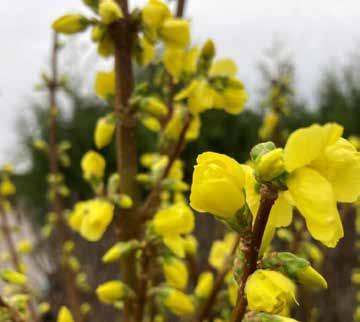
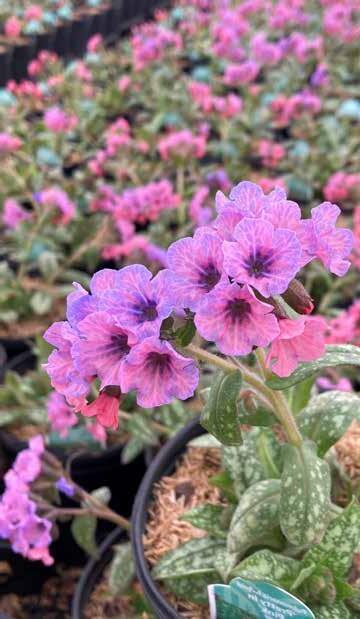
The best part is, landscape professionals will be in the dead center of all of it. The green industry has a tremendous opportunity to teach their clients about these glorious little critters. Yes, some trees will be damaged by the laying of eggs and very small and tender plant material could be netted. Outside of that, just keep the crews in long sleeves and pants because the mowers are going to wreak havoc on cicadas. There are no pesticides to be applied. There are no drastic evasive actions we need to take. This is part of the endless cycle of nature that we are privileged to witness a handful of times in our life. If anything, let’s just be the opposite of the local news and take a calm and measured approach to what they are calling “an invasion.” As a result, ILCA has prepared and shared a short consumer-facing brief members can share on social media. The vibe is fun, not fear.
We cannot underestimate the power of a shared experience. Studies have shown that people prefer to experience something ordinary together versus something extraordinary alone. As nursery and landscape professionals we have the power to equip clients with good information and a sense of excitement. Clients don’t need landscape professionals to be the experts, clients want us to make them the experts in their own social circles. This is going to be a safe and fun topic of conversation across the state for weeks. Every demographic can find joy and interest and cohesion in cicadas. We only get four weeks every 17 years so let’s make them count. Life will be back to normal soon, after the boys of summer have gone.
Sincerely,
 Scott Grams, Executive Director April 17, 2024
Scott Grams, Executive Director April 17, 2024
From Where I Stand — www.marianiplants.com TOLL FREE (866) MARIANI 627-4264
arden
IL The Landscape Contractor May 2024 6
G
Prairie,
President Ashley Marrin
Bret-Mar Landscape Management Group, Inc. (708) 301-2225 ashley@bretmarlandscape.com
Vice-President
Jim Cirrincione Hinsdale Nurseries, Inc. (630) 323-1411 jcirrincione@hinsdalenurseries .com
Secretary-Treasurer
Kim Hartmann Rosborough Partners 847-404-7669 hartmannkim@comcast.net
Immediate Past President
Jeff Kramer Kramer Tree Specialists, Inc, (630) 293-5444 jwkramer@kramertree.com
Directors
Adam Bellas Bellas Landscaping (309) 827-5263 adam@bellaslandscaping.com
Ryan Heitman
The Fisher Burton Company (847) 566-9200 ryanheitman@fisherburton.com
Tom Klitzkie
Nature’s Perspective Landscaping (847) 475-7917 tklitzkie@naturesperspective.com
Michael Massat
The Growing Place Nursery & Flower Farm, Inc. (630) 355-4000 michaelm@thegrowingplace.com
Nikki Melin
Midwest Groundcovers (847) 742-1790 nmelin@midwestgroundcovers.com
Kevin McGowen Kaknes/SiteOne (630) 416-999 kevin@kaknes.com
Becky Thomas Spring Grove Nursery, Inc. (815) 448-2097 bthomas@springrovenursery.com
Mark Utendorf
Emerald Lawn Care, Inc. (847) 392-7097 marku@emeraldlawncare.com
www.ilca.net












President’s Message —
Sixmonths ago I was preparing to spend part of the winter in Florida, showing my two horses in competitions—a dream come true. Besides working at the office, I was working overtime to have both animals in top shape, making sure I was fit, and preparing things so I could work and volunteer remotely. Every day was a long day and I started to feel burned out. I caught myself complaining about the hours I was putting in instead of being thankful for the opportunities.
In a blink of an eye things changed. Shortly before our departure, Cesar injured himself in the pasture and needed surgery. Stella had a flare up from an ongoing metabolic disorder. Neither would compete. These incidents were completely out of my control and just plain bad luck. We cancelled our much anticipated trip.
This experience opened my eyes. I’ve learned to focus on the fact that I have so many wonderful blessings happening all at once— taking over our family business, being the first 18- month president of ILCA, and having two talented horses. I focus on the idea that these opportunities would not have presented themselves if I could not handle them all.

This reminds me of how many of us feel come spring. It’s easy to feel overworked and tired after the long days in the office. Recent years have been incredible for the landscape industry. However, we also recall what it was like during the economic downturn when revenue was cut in half and many companies hung on by a thread. At that time, we would have given anything for the phone to ring. I encourage you to remind yourself of the amazing opportunities we have right now. While we may be stressed, exhausted, and short on patience, focus on the idea that we are never given more than we can handle.
Stay positive!
Ashley Marrin
Haceseis meses, me preparaba para pasar parte del invierno en Florida, con el propósito de presentar mis dos caballos en competiciones—un sueño hecho realidad. Además de trabajar en la oficina, trabajaba tiempo adicional para tener a ambos animales en plena forma, asegurándome de estar en forma yo mismo y preparando las cosas para poder trabajar y ofrecer mi trabajo voluntario a distancia. Cada día era un largo día y comencé a sentirme agotado. Comencé a quejarme de las horas que invertía en lugar de agradecer las oportunidades.
En un abrir y cerrar de ojos las cosas pueden cambiar. Poco antes de nuestra partida, Cesar se lesionó en el pasto y necesitó cirugía. Stella tuvo una crisis de un trastorno metabólico continuo. Ninguno de los dos competiría. Estos incidentes estuvieron completamente fuera de mi control; fueron mala suerte. Cancelamos nuestro anhelado viaje.
Esta experiencia abrió mis ojos. He aprendido a concentrarme en el hecho de que tengo tantas bendiciones maravillosas ocurriendo al mismo tiempo—hacerme cargo del negocio de nuestra familia, ser el primer presidente de ILCA por once meses y tener dos talentosos caballos. Me concentré en la idea de que estas oportunidades no se hubiesen presentado si yo no hubiese podido manejarlas.
Esto me recuerda cómo cuántos de nosotros nos sentimos cuando viene la primavera. Es fácil sentirse abrumado por el trabajo después de días largos en la oficina. Los años recientes han sido increíbles para la industria paisajista. No obstante, también recordamos cómo fue durante el declive económico cuando los ingresos se redujeron a la mitad y muchas compañías colgaban de un hilo. En ese tiempo, hubiésemos dado cualquier cosa para que el teléfono sonara. Los animo a pensar en las oportunidades maravillosas que tenemos ahora. Si bien podemos estar estresados y faltos de paciencia, concentrémonos en la idea de que nunca se nos da más de lo que podemos manejar. ¡Mantengan una.
Actitud positiva! — Ashley Marrin
7 The Landscape Contractor May 2024
Ashley Marrin




Mariani Landscape • Lake Bluff Modern American Gothic
This project presented an opportunity for the landscape architecture team to create a design that fit a home with a modern take on the traditional farmhouse, complementing its unique American gothic and modern style.
Each of the outdoor areas was composed with great intention to fulfill distinct client needs. A large lawn panel was kept open and available for entertaining groups. A vegetable garden was created for the passionate gardener and resident cook. A gravel terrace houses a complete outdoor kitchen. It was made
using board-form concrete pavers, stainless steel grills and industrial black metal bar stools. Steps away, an outdoor TV and viewing area centers around a dramatic fire table. The other side of the terrace houses a dark metal pergola, dining area and a wood-burning pizza oven.
The result is a cohesive, stylistic landscape that parallels the farmhouse structure while introducing an industrial theme to reflect its stygian gothic accents.
The Landscape Contractor May 2024 9
Focus — Native Design Aesthetics
Bloom Time England Comes to iLandscape
by Nina A. Koziol
“Do you need to have training as a garden designer to create dramatic and pleasing plant-oriented design? Of course not, although many might choose this option, just as many will get ideas from books on gardens and be inspired to want to create their own design and plant combinations.”
— Adrian Bloom
Blooms of Bressingham, Bressingham Gardens, and Foggy Bottom are household names in England. You may not be familiar with them, but if you’ve used Geranium ‘Rozanne’ in your projects you can thank nurseryman Adrian Bloom, who introduced the wildly popular plant in the early 1990’s. Bloom shared the inspiring evolution of the nursery and his own gardens with this year’s iLandscape attendees.
“If you’re looking for the perfect perennial, there’s no such thing,” he told the audience. “But ‘Rozanne’ is a lot better than anything on the market.” That workhorse perennial has received numerous awards and accolades here and in Europe. Some of the most interesting perennials have emerged from his family’s nursery with many introduced over the past four decades, including ‘Franz Shubert’ phlox and ‘Red Ace’ potentilla. “My father introduced Crocosmia
i Landscape
‘Lucifer’ and it was really quite a breakthrough and the first of several.”
In 1953, Bloom’s father, Alan (1906-2005), founder of Blooms Nurseries, began developing a garden in front of Bressingham Hall, in Bressingham, Norfolk, England. Apart from a brief, somewhat disastrous couple of years farming in Canada with his young family in the 1940s, the elder Bloom spent most of his long life at Bressingham Hall. He bought the house and 200 acres, which became the famous nursery Blooms of Bressingham, in 1946. He devoted the property to what was then a new concept for using herbaceous perennials—the nursery’s speciality—in island beds. He bred or named 170 plants, wrote 27 books, opened a steam engine museum, and created an extraordinary garden and nursery. Six acres and nearly 5000 different species and cultivars were planted by 1962, when the gardens were first opened to the public.
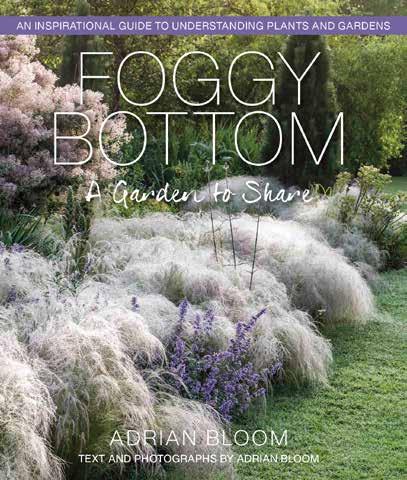
A Brit Abroad
When he was 19, Adrian Bloom took a boat to the U.S. and didn’t call home for two years, but did exchange letters with his somewhat eccentric father. While here, he worked at a nursery in Maryland and then moved to Vermont where he became a camp counselor.
In Michigan, he worked at a pizza shop and bookstore. He was a speed skater and went to Winter Park, CO where the professionals (continued on page 12)
10
The Landscape Contractor May 2024
The i llinois + wisconsin Landscape Show TM P R E M I E R C O N T E N T 2024

Focus — Native Design Aesthetics

(continued from page 10)
trained. For a while, the younger Bloom sold encyclopedias in San Francisco and took a bus from Los Angeles to New Orleans and back to Maryland. Bloom credits part of the time in San Francisco, seeing plants and gardens, that moved him towards his destiny. “I wanted to learn about nurseries and came home for six weeks before working in nurseries in Denmark.”
In 1962, when he returned home from four years abroad, he began developing more gardens on the property, starting his own, Foggy Bottom Garden, in 1967, which is devoted to conifers, heathers, trees and shrubs. “We had our first list of conifers for sale and over one million of them at one time.” Foggy Bottom had more than 500 varieties of conifers in the island beds, many of which have been thinned out over the years. “Blue spruce is one that doesn’t improve with age.”
“In 1983, perennials really became the big thing,” Bloom said. He and his father attended the Perennial Plant Association’s meeting in the U.S. At the time, the nursery was one of the top five in England, employing 200 people. “I travelled around the world and our garden was a place to escape to.” He and his brother took over the family business in 1984.
(continued on page 14)
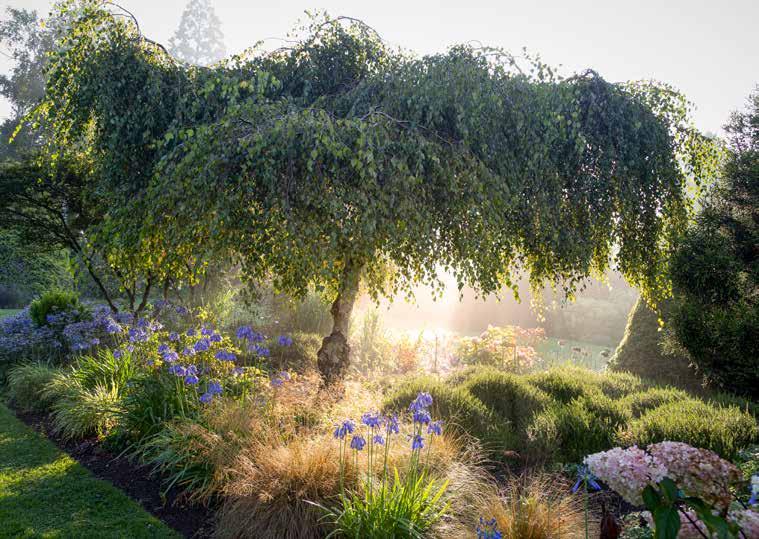
May 2024




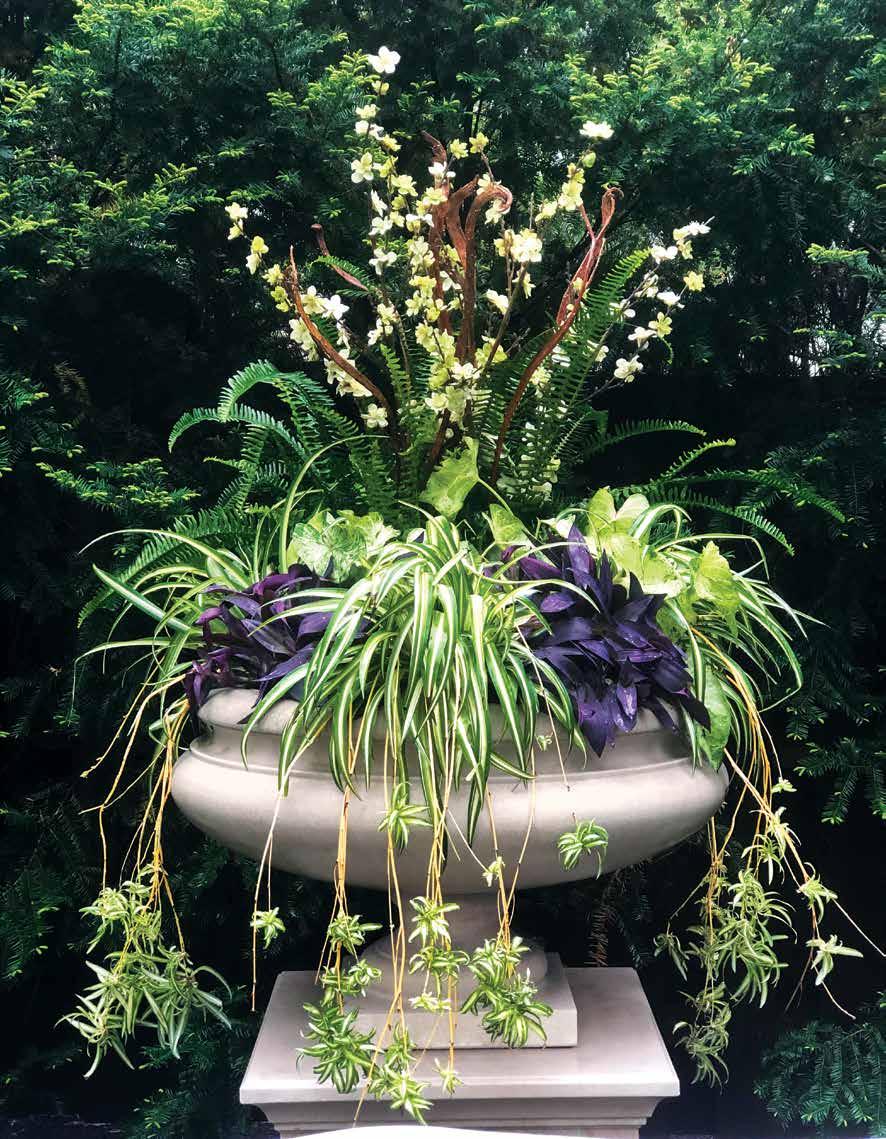

Fine Dry Cast Limestone Planters
® .COM Hand Crafted in Southern Illinois by The Artisans at Classic Garden Ornaments, Ltd.® Design: Hursthouse, Inc., Bolingbrook, Illinois Washington 32 Planter LS 9450 For inquiries call 618 893 4831
LONGSHADOW
Focus — Native Design Aesthetics
(continued from page 12)
In 2000, Bloom added more gardens, linking them to create a diverse attraction for visitors, and joining the gardens together to create the Foggy Bottom Trail, leading from the entrance near the Steam Museum (his father’s collection of engines) to the furthest and lowest end of Foggy Bottom. Today, although changes are still constant, the newer gardens are maturing and new planting designs and plants are being tried. Heirloom and novelty plants meld together with some 8000 distinct varieties on site.
“It takes at least 10 years or more to test a plant,” Bloom said. The nursery releases about six new varieties a year. When his wife, Rosemary, died about 12 years ago, he dedicated a special area of the garden, called Rosemary’s Wood. More than 70,000 people visit the gardens each year to enjoy

the perennial and conifer beds as well as the ancient trees, including a 500-year-old oak.
“I loved all of his plants,” said landscape architect Deirdre Toner of D.T. Design in Old Mill Creek, Illinois. “And, I loved the beauty of ‘walking’ through his garden in the morning.” Many of the atmospheric images Bloom discussed were taken early in the day before he and others began working. They are featured in his new book, Foggy Bottom Gardens.
“Annabelle hydrangea has been a key plant that I’ve used for years,” he said. (What an interesting nod from a Brit to a plant that was discovered in Anna, Illinois.) He cuts the stems right to the ground. “They don’t grow quite as tall or flop as much by doing that.” And, gold foliage is very popular in the United Kingdom. “I say that gold is good. We have cooler summers and more rain. Gold highlights the garden on dull days.”

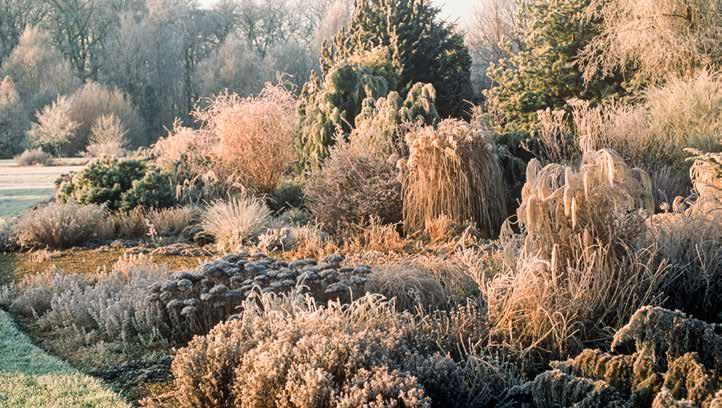
14 The Landscape Contractor May 2024


13920 S. ARCHER AVE. LOCKPORT, IL 60441 (815) 838-0863 | HOMERINDUSTRIES.COM | ORDERS@HOMERTREE.COM QUALITY MULCH DELIVERED QUICK
Focus — Native Design Aesthetics
Spring Demand for Warm-Season Grasses
by Krystal Flogel
As growers, we’re always looking for ways to improve production and increase sales, whether it’s by finetuning our production plans to better meet demand, or adjusting our growing practices to reduce shrink and improve plant quality. If we want to reach our full potential, we also need to identify areas of missed opportunity. I think we can all relate to this, regardless of our role in the industry. Landscape contractors see missed opportunities in the jobs that are turned down or delayed due to lack of labor. Labor shortages have been a major cause of missed sales for garden centers over the past several years as well, with understaffed IGC’s unable to unload trucks, refill benches, and help customers. In nursery production, missed opportunities often take the form of plant varieties, brands, or product lines that we aren’t growing. But we also miss out on sales when we don’t have the right plants ready at the right times. Sometimes the solution to this is as easy as adjusting our planting schedule, but other times it’s not so simple. Among the greatest challenges growers face here in the Midwest are the limitations caused by our short growing season. The latest USDA Plant Hardiness Zone Map, which was released last December, provided us with a stark visualization of our warming climate — it showed the expansion of zones 6 and 7 throughout Illinois and the near disappearance of zone 3 in
Wisconsin. Essentially half the country was shifted into a warmer hardiness zone. But what the map doesn’t portray is the increasing unpredictability of weather events caused by climate change. Milder winters and earlier springs are leaving plants more susceptible to damage from late spring frosts. For a nursery like Mariani Plants, where the bulk of our production takes place in outdoor, unheated growing ranges, the growing season is only about six months long, and the plants we grow are typically at the same stage of growth as those in the landscape. There are many benefits to this type of production, but it also poses some challenges. For one thing, not all plants are retail-ready at the times when customers are ready to buy them. Spring demand for warm-season grasses is a perfect example of this.


Some of our favorite ornamental grasses are classified as warm-season, including Panicum (switchgrass), Miscanthus (maiden grass), Hakonechloa (Hakone grass), Andropogon (big bluestem), Schizachyrium (little bluestem), Pennisetum (fountain grass), Calamagrostis brachytricha (Korean feather reed grass), and Sporobolus (prairie dropseed), just to name a few. Warm-season grasses don’t break dormancy until late spring, they bloom from summer to fall, they thrive in hot temperatures, and they don’t begin to actively grow until soil and air temperatures reach 70 and 80 degrees
16 The Landscape Contractor May 2024
Hakonechloa macra ‘Aureola’

Improved Landscape Performance
The classic Oakleaf Hydrangea gets an upgrade with two new varieties from Star® Roses and Plants. Get the beautiful flowering and fall color you expect from a Hydrangea but with improved disease resistance, reblooming, and a more manageable habit.

AUTUMN REPRISE™
Hydrangea quercifolia '1925querrep' PPAF
+ Earlier to bloom with strong rebloom.
LI ’ L ANNIE OAKLEAF™
'Oakann1588' PPAF
+ Mature size under 5 feet.



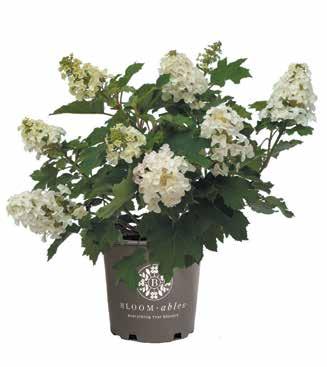


The Landscape Contractor Autumn Reprise ™ Li’l Annie
™ Pollinator friendly; burgundy fall foliage Li’l Annie Oakleaf Oakleaf Hydrangea Scan for detailed plant specifications. Find a wholesale grower near you: 1-800-457-1859 www.StarRosesandPlants.com
Oakleaf
Focus — Native Design Aesthetics
Fahrenheit, respectively. Cool-season grasses, on the other hand, typically flower from spring to early summer, grow actively in the cooler temperatures of spring and fall, and often go dormant or semi-dormant in midsummer. They include Calamagrostis x acutiflora (feather reed grass), Festuca (fescue), Deschampsia (tufted hairgrass), Helictotrichon (blue oat grass), and Sesleria autumnalis (autumn moor grass).
The differences between coolseason and warm-season grasses are complex and originate at the molecular level. These two groups of plants are also classified as C3 and C4 plants because of the different pathways they use to fix carbon through the process of photosynthesis. The majority of plants on Earth, including the cool-season grasses, are C3 plants. They use what we typically think of as the older, conventional type of photosynthesis that produces a three-carbon compound. Warm season grasses use C4 photosynthesis, which is more efficient than C3 photosynthesis and allows the plants to retain more water throughout the day by avoiding

photorespiration. These differences are important because they help us understand why warm-season grasses have evolved to thrive in hot, dry environments, and cool-season grasses are more frost-tolerant and better adapted to low light levels and cooler temperatures. It not only explains why fescue and switchgrass thrive at different times of the year, but it helps us identify the broader implications related to nursery production and the role of warm-season and cool-season grasses in the landscape.
Because they grow so differently,
we take a much different approach to warm-season grasses than coolseason grasses when it comes to our production practices. For one thing, we can pot most cool-season grasses, like Calamagrostis ‘Karl Foerster’, in late summer or early spring and they will easily finish in time for spring sales. But warm-season grasses are a different story. We need to pot a Miscanthus or Panicum early enough in the summer to allow time for the roots to develop before cooler temperatures set in. If we pot in spring or fall, the liner will sit dormant until temperatures are warm enough for active growth to occur. Even if the plants are well-rooted going into fall and they overwinter successfully, it’s just not possible to produce a full, retail-ready warm-season grass in spring without using supplemental heat in our climate.
If you have ever maintained a customer’s lawn or landscape, you’re probably well aware of the dynamics of warm and cool-season grasses, especially when it comes to controlling weeds. Warm-season species, like crab-
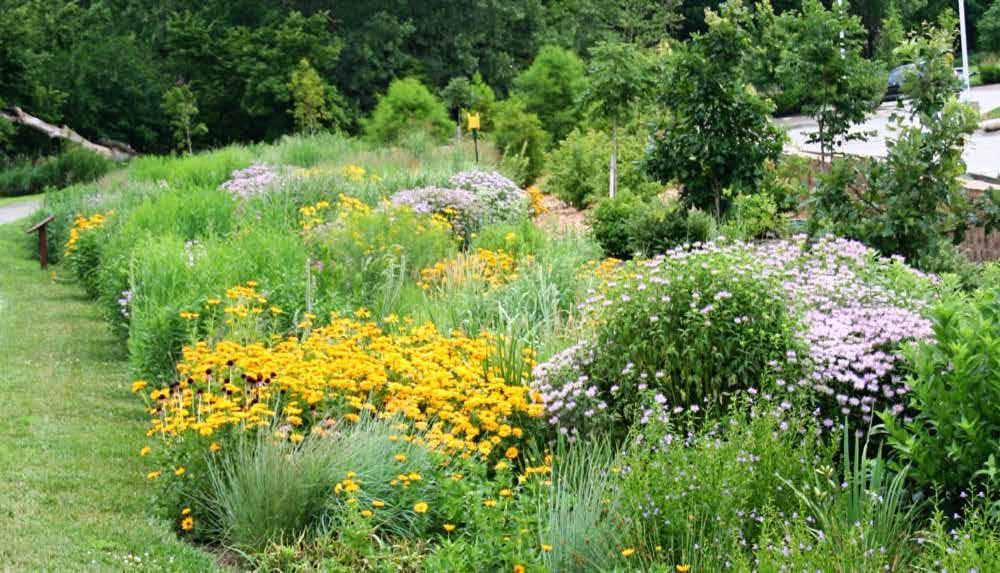
The Landscape Contractor May 2024 18

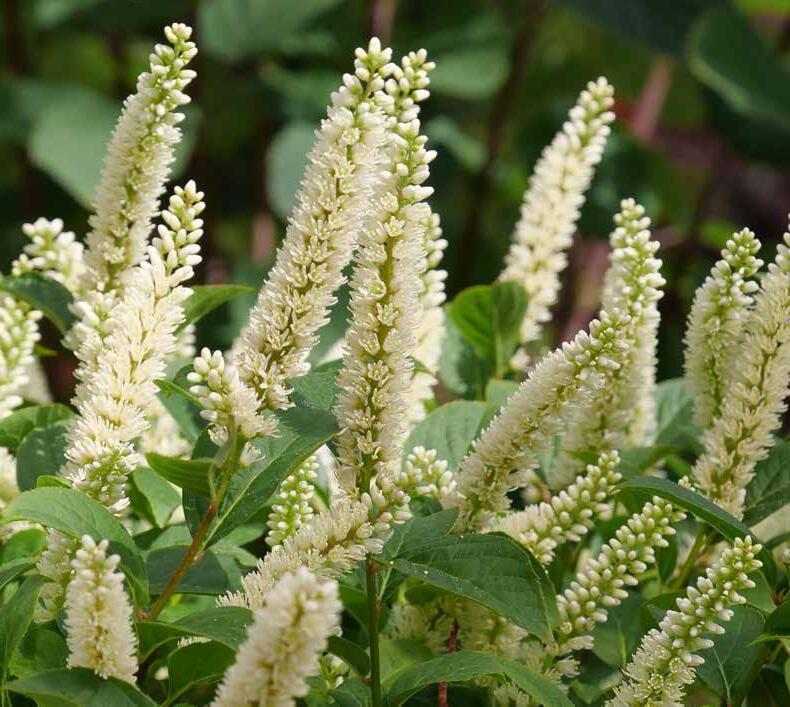
FIZZY MIZZY ®
Itea virginica ‘SMNIVMM’ PP#33,549; CBRAF Native species | Fragrant | Compact

SUMMER USDA 5-9
2-3’ tall + wide
Alsip Home & Nursery
Frankfort, IL • 815-469-1044
Creekside Gardens Collinsville, IL • 618-344-7054
A sweetspire that literally stands out in the landscape! Abundant upright flower spikes bloom in early summer, bridging the gap between the seasons. This adaptable, compact shrub can be sited full sun to full shade, expanding its landscape applications.
AVAILABLE FROM THESE SUPPLIERS
Hart’s Nursery
Bushnell, IL • 309-772-9517
Home Nursery Albers, IL • 618-248-5194

Midwest Groundcovers St. Charles, IL • 847-742-1790
19 The Landscape Contractor May 2024 Available from Proven Winner s ® ColorChoice® growers www.provenwinners-shrubs.com TRIALED. TESTED. PROVEN .
SCAN TO LEARN MORE


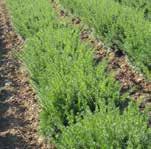

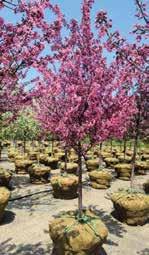

Focus — Native Design
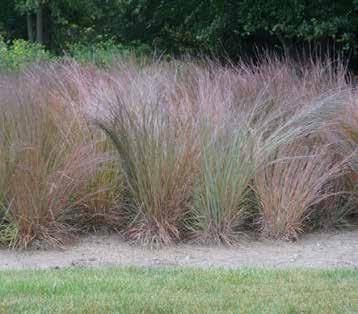



grass, are particularly competitive because they thrive during the hot, dry weeks of summer when our cool-season turfgrass varieties are often dormant. Since quackgrass is a perennial cool-season grass, its annual growth cycle starts in early spring, giving it an advantage over plants that start from seed or are late to emerge. It’s active again in fall, after many of our ornamental plants are dormant or have been cut back. Clearly, warm and cool-season weeds benefit from their opposing growth cycles, each one flourishing while the other is dormant. We can apply these same principles when it comes to designing with warm and cool-season ornamental grasses in the landscape. By balancing their use in a design, we can extend the season of interest and avoid large gaps in the garden when one or the other is dormant. Cool-season grasses can be strategically planted in front of warm-season grasses, since they provide an immediate impact in spring and hide the short, dormant clumps. By the second half of summer, the warm-season grasses will be ready to play their part
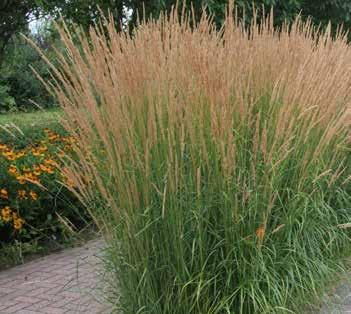
20 The Landscape Contractor May 2024
Aesthetics
When You Need the Very Best... 847.683.3700 www.wilsonnurseries.com
Aesthetics
while our cool-season varieties take a break. Native warm and cool-season grasses have also evolved to form complementary relationships that benefit the environment in terms of erosion control, water quality protection, and wildlife habitat creation. Cool-season grasses provide more nutrient uptake benefits in the spring and fall when warm-season grasses are dormant. Conversely, warm-season grasses develop extensive root systems that can immobilize large amounts of excess nutrients in the summer months. This is only one example of the complex plant relationships we find in nature.
Having said all this, we know that customer demand isn’t always correlated with the timing of plants in the landscape, especially in spring. Don’t get me wrong, we will always need to have blooming Dicentra available in May, just like we will always sell more Rudbeckia at the same time that our native black-eyed susan is in bloom along the highway. But, after a long and dreary Midwest winter, gardeners crave color. Not only that, but we exist in an on-demand economy
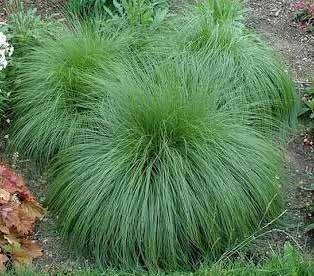
where consumers are accustomed to getting what they want, when they want it. In an industry like ours, where it’s not uncommon for garden centers to generate over 50% of their revenue over the course of a single month, we need to be ready to hit the ground running when the first warm days of spring hit. As much as we may wish that our customers’ requests would align with what looks good in the nursery at any given time, we are, first and foremost, in the business of selling plants. This is why we custom-grow perennials each spring, using supplemental lighting and heat, in order to have blooming, retail-ready plants available in late April when it’s not uncommon for temperatures to dip below freezing. But it’s important that we continue to educate our end consumers on topics like this; if they understand how and why plants grow the way they do, they’re more likely to be successful, and that will benefit us all.
















21 The Landscape Contractor May 2024
Bagged or bulk? Mulch or rock? We’ve got you covered! 711 S Material Road Romeoville, IL 815-836-0086 sales@rocksetc.com 18715 Route 84 N Cordova, IL 309-654-2261 sales@xylemltd.com Mix and match! Rock, mulch, boulders, flagstone, & more—all on the same truck! Call your sales rep today! Bagged or bulk—
Special Feature

When our clients request landscape designs and property improvements, the inclusion of plant materials is quite likely as the goals of beautification are paramount for everyone. However, also addressing space to maximize functionality is related directly to the input and expectations (both specific and elicited) from our clients.
Outdoor structures, decks, patios, retaining walls, fences, etc. all serve a function and are typical in our design considerations and configurations. The continued desire to be outside for gathering with family and neighbors, certainly magnified by COVID, continues to be a popular and unsurprising priority. When I’m meeting with clients, as we discuss improvement of the landscape, we also have a general discussion about how these elements will help fulfill their goals. The interest in safely accommodating a fire outside inevitably enters into the equation.

One of my “check list” questions without fail during these consultations is, “Are you interested in a fire pit?”
Humans gathering around a fire is not a new concept, of course. The fire pit itself, has a long history dating back to the Paleolithic Period when fire was used for heat, safety,
cooking and community gatherings. Native Americans in the Great Plains utilized a system called the “Dakota Fire Pit”. Consisting of two connected holes, one hole contained the fire beneath grade while the other hole was a side tunnel feeding air to this well-insulated combustion chamber. This ingenious system kept the fire from potentially hostile observation and heavy winds while minimizing any smoke. This system still has military and camping relevance. Some of my fondest memories from childhood through five decades of life include time around a fire and I have a simple fire pit at home that sees constant use.
Responses from clients to my question regarding the inclusion of a fire pit vary and are frequently fluid. Some clients will indicate a quick “yes” and have an interest in a more modern fire pit arrangement or perhaps outdoor fireplace that works in tandem with their exterior living space. These areas may also include additional elements like the patio, seating, tables, arbor for shading, outdoor grill, etc. Some might decline designating a permanent spot for a fire pit with an interest in a more portable situation such as
22 The Landscape Contractor May 2024

smaller, moveable systems (i.e. chiminea or moveable fire pit system). Portable devices are similarly intended to contain and control the outdoor fire but the flexibility in their location has a certain appeal to many and we can still provide designed spaces for these systems.
Further consideration regarding a permanent fire pit revolves around the context of frequency of use, safety, general care and cleaning and perhaps how many people might use that space (capacity). I’ve designed a wide range of fire pit situations based on the client’s input but am sure to connect this feature to the design itself and respect the client’s inputs and expectations. Making the space usable for multiple functions is also prudent as is enfolding it within the context of the planting design and overall plan. Some of the most intimate and successful situations that include fire pits also address additional gathering needs related to seating space,
room for dining, privacy and certainly safety.
The fire pit, whether rustic or modern, can anchor a gathering space and offer the perfect combination of versatile heat and a cozy ambiance. There is some ambiguity in terminology regarding a fire pit but for the sake of this article, a fire pit is defined as a designed system to contain fire and prevent it from spreading. Fire pits are typically wood-burning or gasburning systems (natural gas or propane) and certain styles, designs and methods of use help alleviate concerns about excessive smoke and fire safety. Regardless, the fire pit is an instant “party starter” and can be a stand-alone component, anchor a patio or complement an outdoor fireplace or outdoor kitchen. A well-designed fire pit that is united with the design scheme will contribute to a comfortable and inviting space and increase home value.
(continued on page 24)
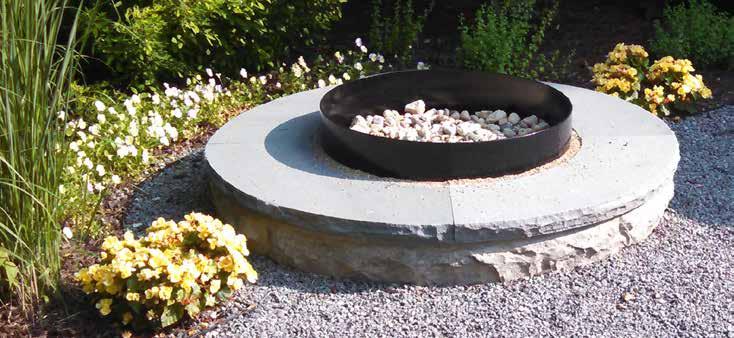
23 The Landscape Contractor May 2024
Special Feature
(continued from page 23)
Types of Fire Pits
Wood-burning or gas-burning becomes the initial inquiry regarding how the fire pit system is fueled. Natural gas (proven to be most cost effective) and propane style fire pits are common although they come with their own installation protocols, care and safety considerations. With increased public attention regarding sources of pollution and global warming, wood-burning systems are coming under more scrutiny due to particulate emissions and fire concerns associated with areas of drought.
As mentioned above, there are myriad moveable fire pit systems including those that travel easy for camping or tailgating. There are a wide range of Corten steel fire pit situations ranging from simple rings to elaborate “fire balls” with ornate shapes. Open flame fire pits could include BBQ amenities like a removable cooking grate. I like
my portable system as I can move it to various locations but each of those locations has also been designed to handle a certain capacity of moveable seating in a comfortable and safe situation. While I love the smell of a good fire, I don’t want to be constantly shifting seats to avoid burning eyes and absorbing that smoky smell on all my clothes.
The next generation of smokeless fire pits offer the same benefits of a wood burning fire but not the smoke! Designed with double walls, these pits leverage the difference in air temperature between the walls to create and increase superior airflow which in turn, creates a secondary burn or combustion – thereby minimizing smoke. In essence, this is a hotter fire that burns its own smoke; the bane of any party. This system is more environmentally friendly. Custom, dimensional inserts of this “smokeless style”, usually square or round, can be inserted into a block or stone surround for the unit and are ready to go. A fire pit heat
deflector, available for most types of fire pits, pushes heat down and out (deflects heat from potential overhead obstructions like patio roofs, tree branches, etc.)
Free-standing fireplaces, while offering similar benefits of warmth and cooking potential, are their own category of feature and defined as an “enclosed and permanently secured outdoor fire receptacle which incorporates a permanently affixed chimney or flue, and is constructed of brick, rock or other masonry.” They certainly are part of the discussion when clients are interested in that outdoor fire and a cozy experience although they also become participatory in the design as well and warrant their own research.
Basic Considerations & Safety
Prior to incorporating a fire pit into any design, checking local fire pit codes is vital. Some communities require a permit for a permanent fire pit while (continued on page 26)
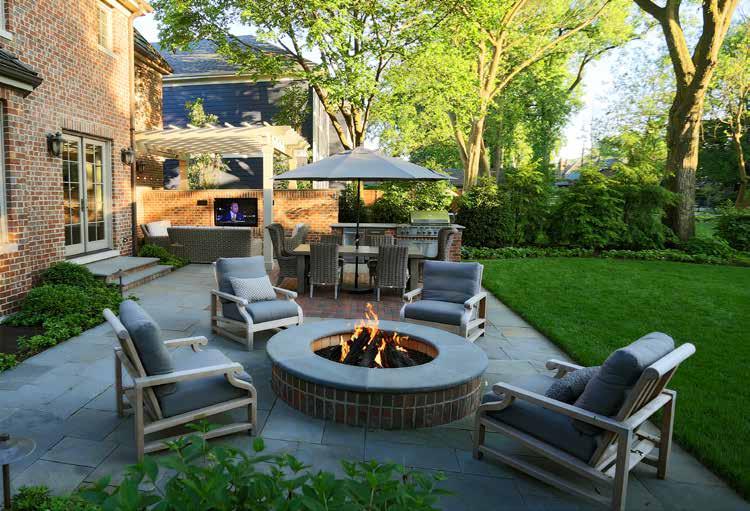
24
The Landscape Contractor May 2024
—

Special Feature
(continued from page 24)
others might also require on-site inspection by local fire officials. Your client can likely source the relevant statutes and administrative codes as well as applicable fire codes, regulations and provisions. Properties that are part of a Homeowners Association (HOA) may also have additional codes and rules of note regarding fire pit styles and use. Obviously, this information will have an impact on the scope of what is allowed although moveable systems, of which there are many, may be exempt from some of the restrictions intended for permanent fire pits and outdoor fireplaces.
Wisely choose a safe location with plenty of overhead clearance including a safe distance from any outdoor string lights or power lines. The space should also be free from low hanging branches. Designing or placing the fire pit on a stable, level surface of stone, brick or concrete is recommended and there are various “add-ons” to a fire pit such as a
spark screen to further mitigate safety concerns. Proximity to a water source is never a bad idea. Moveable fire pits on decks should be placed on a “fire pit pad” and have the same safety concerns as permanent installations. Fire pits should be placed at least 10-15’ from lot lines and most safety recommendations further recommend a 15-25’ distance from combustible materials like buildings, sheds, decks and fences. Again, local regulations may provide additional guidance on these restrictions. Get the “lay of the land” when on site prior to suggesting a location. I’ve had clients designate a fire pit area a distance from the back porch or patio but more often, they’re interested in how to incorporate this feature into their outside living area immediately behind the home.
Design Ideas
The clients will help guide your outdoor living room design suggestions and the ideal location for a fire pit may very
well present itself. The challenge with including a permanent fire pit (or outdoor fireplace) in the landscape design is to make it blend seamlessly into the surrounding design while also reflecting the personal flair of the clients. Fire pit materials may complement the surrounding design and existing paving and other material choices. Elevated fire pits designed with wide coping will allow room for meals. I’ve designed elevated fire pits that when not in use, can accommodate large, moveable container inserts of flowers (appearing as a nice planter until a fire is desired). I’ve also recommended custom tabletop inserts that allow an elevated fire pit to become a central location for cards or dining on a solid, level surface. An empty and currently dormant fire pit can be converted to another usable function.
Sunken, or below grade, fire pits will block the wind and create a cozy setting. Existing topography and drainage (continued on page 28)

26 The Landscape Contractor May 2024
Chicagoland area with of 400 acres of quality field-grown nursery stock .
Cedar Path Nurseries has two conveniently located sales yards, Lockport and Barrington, to better serve our clients.

Growers & Distributors of Quality Nursery Stock
We are the premier shade tree grower in the Chicagoland area with of 400 acres of quality field-grown nursery stock .
Growers & Distributors of Quality Nursery Stock
Growers & Distributors of Quality Nursery Stock

Cedar Path Nurseries has two conveniently located sales yards, Lockport and Barrington, to better serve our clients.
We are the premier shade tree grower in the Chicagoland area with of 400 acres of quality field-grown nursery stock .
Cedar Path Nurseries carries a full line of B&B trees and shrubs, container shrubs, perennials and groundcovers. Not only are we your onestop -shop, but we are sourcing experts. We look forward to assisting on your next project.
Cedar Path Nurseries has two conveniently located sales yards, Lockport and Barrington, to better serve our clients.
We are the premier shade tree grower in the Chicagoland area with of 400 acres of quality field-grown nursery stock . Cedar Path Nurseries has two conveniently located sales yards, Lockport and Barrington, to better serve our clients.
Cedar Path Nurseries carries a full line of B&B trees and shrubs, container shrubs, perennials and groundcovers. Not only are we your onestop-shop, but we are sourcing experts. We look forward to assisting on your next project.
Cedar Path Nurseries carries a full line of B&B trees and shrubs, container shrubs, perennials and groundcovers. Not only are we your onestop-shop, but we are sourcing experts. We look forward to assisting on your next project.

Cedar Path Nurseries carries a full line of B&B trees and shrubs, container shrubs, perennials and groundcovers. Not only are we your onestop-shop, but we are sourcing experts. We look forward to assisting on your next project.

Lockport, Illinois



15235 W. Bruce Road, Lockport, IL 60491 Office 815.838


Lockport, Illinois
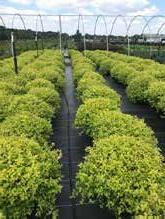

Barrington, Illinois
Barrington, Illinois
15235 W. Bruce Road, Lockport, IL 60491
Barrington, Illinois 190 W. Penny Road, Barrington, IL 60010



Barrington, Illinois
190 W. Penny Road, Barrington, IL 60010
Office 847.551.3700 | Fax 847.551.3707
Office 815.838- 4900 |Fax 815.838.4999
190 W. Penny Road, Barrington, IL 60010 Office 847.551.3700 | Fax 847.551.3707
Office 847.551.3700 | Fax 847.551.3707
SALES@CEDARPATH.NET | WWW.CEDARPATH.NET
SALES@CEDARPATH.NET | WWW.CEDARPATH.NET
15235 W. Bruce Road, Lockport, IL 60491 Office 815.838
SALES@CEDARPATH.NET | WWW.CEDARPATH.NET We are the premier shade tree grower in the
SALES@CEDARPATH.NET | WWW.CEDARPATH.NET 27 The Landscape Contractor May 2024
(continued from page 26) considerations enter into the equation for these spaces; frequently referred to as a “fire pit lounge”. These recessed settings can include space for moveable seating or permanent seating. Sunken or recessed firepits keep the flames from interfering with a view or sight line.
Human desire to relax around a fire has a long and continuing history. For those that wish to have fire pits incorporated into their landscape designs, there is no shortage of potential creativity and opportunity for offering these customized, safe and cozy components.




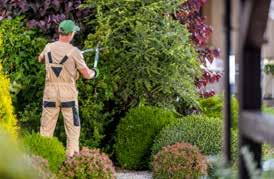


https://bit.ly/WorkShareILFlyer

Special Feature — Retain Talented Employees When the Work Slows Down! WorkShare IL Helps Employers: Reduce Payroll During Slow Periods Without Layoffs Save on Recruiting, Hiring & Training Maintain a Trained Staff Ready For Business Upswings



CONTACT OUR SALES TEAM: P: 630-365-1990 mtsales@midwest-trading.com midwest-trading.com THE TEAM TRUSTED BY LANDSCAPE PROFESSIONALS From providing quality mulch and soil amendments to securing transportation and scheduling deliveries, our team provides solutions so you and your team can focus on getting the job done.
Nature’s Perspective Landscaping Wins
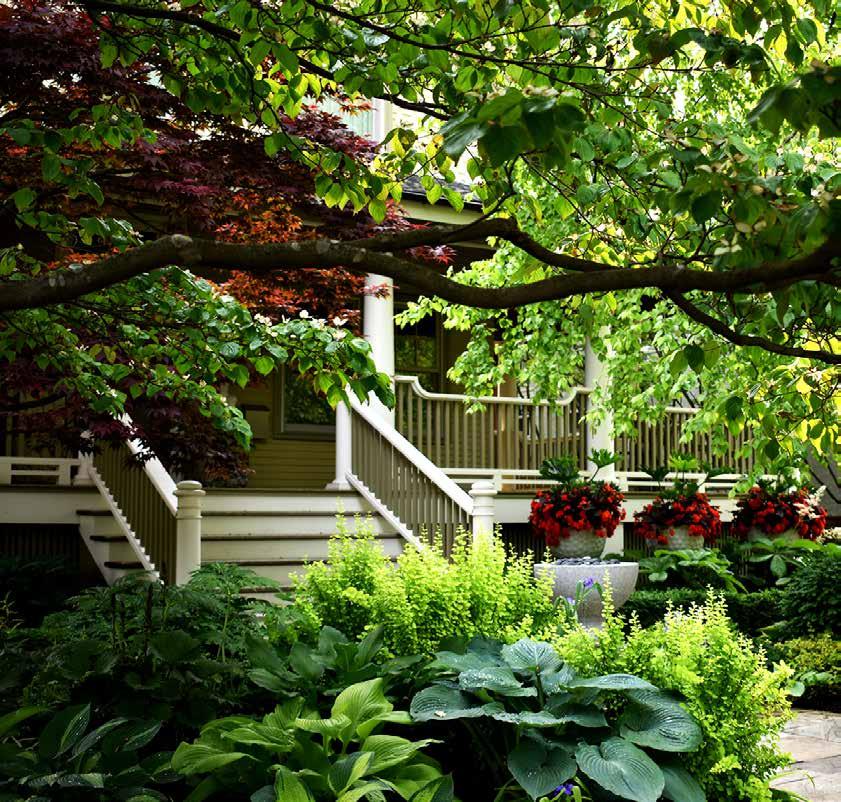
30
Choice Award
Focus — Excellence in Landscape Professionals’
The Landscape Contractor May 2024
The goal of our client was to have a beautifully maintained garden and lawn that has come to be expected of those living along Sheridan Road.
Award
Wins Professionals’ Choice Award
by Heather Prince
You would never suspect from the front elevation of this stately Victorian, that a botanical treasure lay behind its pots of colorful annuals and wraparound porch. Shaded by an enormous river birch, this Evanston property features a hidden garden right on the shores of Lake Michigan.
Ben Klitzkie, director of landscape maintenance at Nature’s Perspective Landscaping in Evanston, Illinois, has been overseeing this extraordinary property which won the Professional’s Choice Award at the 2024 iLandscape show. The team at Nature’s Perspective has been maintaining the property since 2006 to create a lush tranquil estate in the heart of Evanston.
A Plant Collector
As you approach the front porch of the home, you walk up an elegant limestone path bisected by a large granite urn cleverly sunk below grade and anchored with black Mexican pebbles. It’s a hint that these homeowners are more than your average suburban garden aficionados. The plush shade gardens beneath the cool branches of the birch tree fill every inch of space with layers of foliage and flowers. Only in the parkway is there a patch of lawn. Crisp ceramic containers are filled with bright annuals to welcome visitors.
The rear elevation is a long expanse of gardens and lawn that ends at the lake. A series of subtle garden rooms are laid out with curvilinear beds edged with limestone surrounding a pristine lawn. As you walk to the lake, a large round turf panel edged in stacked limestone brings you before a set of shallow steps that leads to a pergola overlooking the water and an enclosed studio. “We started by doing a lot of the hardscaping work,” said Klitzkie. “We did all the dry stacked limestone walls with material that is larger than typical. Those blocks are about 12 inches wide by 5 to 6 inches high giving them an elongated feel. The circle bog or shallow pond was installed to feature iris, water lilies, and other wet-loving plants.”
Layered planting beds create screening with understory trees and large shrubs that also provide varied shades of fall color. Pieces of garden art are thoughtfully tucked in here and there. A fountain quietly burbles in the background. “The homeowner is very private,” commented Klitzkie. “However, he thought of a lot of the ideas and worked closely with us to implement them, which was interesting and quite special.”


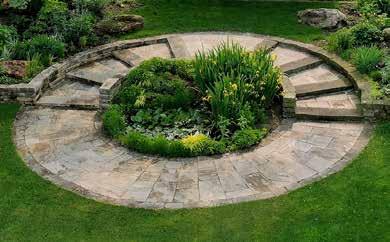
31
The Landscape Contractor May 2024
Focus — Excellence in Landscape Professionals’

The largest challenge we faced this year in maintaining this lakefront estate was the implementation of Evanston’s gasoline leaf blower ban. We needed to learn how to adapt quickly to provide the same level of precision in our work with far less powerful tools. We look forward to seeing how these tools perform during fall cleanup and against this property’s large cottonwood tree.
Choice Award

Award
Focus — Professionals’ Choice Award
The homeowners are plant collectors and there’s plenty of space to accommodate the client’s love of new and exciting selections. “He is always finding new, strange, and weird things to try,” observed Klitzkie. “He’ll go visit a garden center and bring something home like a new type of hosta that we’ll have to fit in somewhere. He has the space, of course, and it’s a fun challenge for us to work with his latest plant find.”
Existing Challenges
One of the delightful challenges of the back gardens is the huge mature cottonwood that dominates the yard. “It’s a 70 to 72-inch diameter tree right smack in the middle of the back property,” reported Klitzkie. It provides the primary canopy for the shade gardens but comes with its own set of maintenance challenges from the huge leaves that fall early in autumn to the massive clouds of cottony seeds that coat everything in the spring. The homeowners require a tidy, formal approach to their landscape, so the team at Nature’s Perspective is there weekly for weeding, bed maintenance, and enhancements. This includes quality time dealing with everything the cottonwood drops.
The soils are also a surprising challenge. “There’s a couple inches of typical soil and then it turns into this kind of interesting black sand and then if you dig down another foot it’s
just sand,” commented Klitzkie. “There’s a high volume of watering that needs to happen to keep all the lawns happy.”
The team also tussles with buttercup or lesser celandine (Ficaria verna) in the turf, which is very common, especially near the lake. This invasive cool weather plant thrives in the longer spring that is caused by the cold lake waters.
Lake Michigan itself is a temperamental challenge to this landscape. The property used to have a large swimming beach until the high waters of recent years washed most of it away. Winter storms also tend to fling gravel up into the lawns. “We rake the grass as part of spring cleanup to get the gravel back out,” said Klitzkie. The fierce winter winds are also a factor. “They can cause some issues with the Australian pines by the water and there’s mature rhododendron there that we have to wrap up to prevent winter burn.”
New Obstacles
The biggest hurdle was a new one in 2023 – Evanston banned gas-powered leaf blowers. This property was one where leaf blowers were an essential piece of equipment to maintain it to the level the homeowners demanded, especially since they like to host parties and fundraisers in the gardens.
“We ended up switching to all battery-powered equipment for our properties in Evanston,” reported Klitzkie. “If we

34
Learning how to use these tools now and implementing them into our everyday maintenance work has made us ready for when other cities decide to make the switch as Evanston has. The Landscape Contractor May 2024

Focus — Professionals’ Choice Award
had an unlimited budget, we’d do it everywhere. There were definitely price increases that had to come along with that just because it requires more time on site. By and large people were understanding because they knew Evanston had implemented the ban. They also appreciate how much quieter it is. It was night and day last year going from Skokie or Wilmette to Evanston. It was so much quieter on a nice day; it was really noticeable.”
There were a number of benefits for the crews of Nature’s Perspective with the new battery-powered equipment. “We saved 800 gallons of gas,” reported Klitzkie. “The whole game with the battery-powered and electric equipment is how long is the return on investment? And so, in the first year we’re starting to see that with fuel savings.” The crews, while initially skeptical, quickly embraced the new equipment. “We didn’t have crews mixing fuel on the trucks, so no spillage or leaks. We could fix things quickly if they failed without having to mess with a carburetor or intricate parts. Even though it’s hard to quantify on the balance sheet, it still saves you time and effort and cost to just be able to swap something out quick as a bunny.”
The crews also found the electric equipment more comfortable to use. “There’s something about loud that equates to power,” commented Klitzkie. “Power is good, right? The macho guy thing, right? And so initially a lot of our guys
were not excited about this change. But by the end of the season, they were totally won over. They were appreciative of how they didn’t smell like gas at the end of the day. The equipment is nice and new and ergonomically built with well-planned little things like a comfortable waist strap. I talked with everyone and those things seemed to go a long way to really prove their value to the guys.” Klitzkie is also finding that the lighter equipment means less stress on the body and so crews can get more done in a day.
Keeping the Client Happy
Although the clients weren’t thrilled with the price increase due to a change in equipment, they understood. The team at Nature’s Perspective was able to deliver a consistent experience and maintain a high level of excellence. “The foreman who oversees the site has been there for years,” said Klitzkie. “He and his guys know the property very well and know the clients’ expectations. The crew does an excellent job, and the homeowners are very pleased.”
This elegant oasis continues to delight the homeowners and remains a rare, private piece of the Evanston lakefront. “It’s very unique,” commented Klitzkie. “It’s just a special little place. I’m happy to go there every chance I get. Not only do I see or learn about a new plant that they’re trying, but it feels like you’re in a whole different place.”

36 The Landscape Contractor May 2024
Although the electric blowers are far less powerful than their gas counterparts, this property helps showcase the abilities of the battery-powered blowers, which far exceeded our expectations.



GET A LOW-MAINTENANCE LANDSCAPE CONSTANT reblooming color COMPACT mass planting TO LEARN more and place your order: 1-800-457-1859 Petite Knock Out® ‘Meibenbino’ PP 30,811 U.S. Pat. No. 11,252,928 U.S. Pat. No. 11,917,978 CPBR 6,553 www.KnockO ut Roses. com CREDIBLE 2023 AGRS™ Winner & 2023 A.R.T.S. Winner
Focus — Native Design Aesthetics
Native Garden Design Principles
by Christa Orum-Keller
Throughout history, there have been multiple movements toward naturalistic or wild garden design styles. Forces behind such trends include a reaction to highly manicured garden styles, such as the Wild Garden movement in the late 1800s, spearheaded by William Robinson (18381935) and Gertrude Jekyll (1843-1932). Historically, naturalistic garden inclinations can be a response to the high labor cost of maintaining controlled cultivated landscapes, or they may be a glorification of nature and the peasant-style garden. Today, more than ever, we are motivated to utilize nature inspired garden design to bring environmental benefits. Sorting out how best to integrate the Wild Garden in today’s turf dominant and mostly manicured urban landscapes requires sensitivity to traditional design principles. Even for the most enthusiastic pollinator proponent, a well designed and aesthetically pleasing native garden will inspire neighbors to venture out of their comfort zone and attempt to create their own pollinator habitat rather than causing them to worry or complain about the concerning wild garden of their neighbor.
Some challenges when designing with native plants:
1. Using too many native plant species
2. Overwhelming the design with very tall native species
3. Effectively blending native plantings with manicured landscape elements
4. Working under the assumption that native plants require no maintenance
When pondering effective native design aesthetics, we can ask ourselves: “What makes any landscape or any visual image appealing?”
1. Resist the urge to add too many native plant species
While vast acres of highly diverse prairie is breathtaking, a typical backyard is unable to provide the same
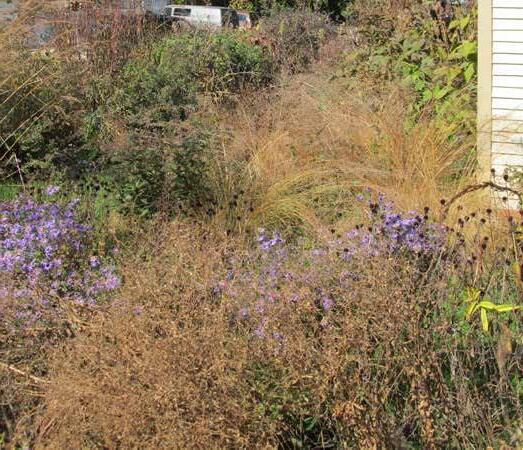

38 The Landscape Contractor May 2024
Too
be
the eye Camassia
much diversity can
unsettling to
and Carex bromoides
for Success
impression due to the smaller scale. Variety brings interest and beauty, so long as it does not bring so much diversity that your eye cannot calm and settle. When designing with native plants we inherently lean into diversity and understand its ecological benefit, but too much diversity in a small space can create distraction and an erratic look. Maintaining a controlled palette of plants can be a stabilizing design foundation. Start simple and focus on a combination of 2-5 species. Repetition of color, texture, or form, creates a pleasant visual energy, but too much repetition equates to visual boredom. Choose a dominant species for each season or month and use a large enough quantity of each of these plants in repetition, to create an anchoring and enjoyable visual foundation. Place seasonal repetitive plants in intentional drifts which cause the eye to move through the garden rhythmically with ease.
2. Be careful not to overwhelm with very tall native plant species
Sculptural elements in a naturalistic garden bed can create a visual pause or excitement. Some of our tallest and most coarse prairie plants can act as sculptural

elements in a native planting such as Prairie Dock, Compass Plant and Joe Pye Weed. People are often intimidated by very tall plants, and many of our Illinois natives reach 6-10’ or more in height and with rich garden soils, they can stretch even higher. Do not be afraid to use tall species, but use them sparingly and with clarity of purpose for emphasis. Consider planting sculptural groupings of 3 or 5 tall species in a cluster surrounded by markedly shorter species.
3. Effectively blend native plantings with manicured landscapes
If there is a functional purpose for greater diversity, such as a pollinator garden, consider creating a border of soft and fine textured species such as Sporobolus, Carex species or Eragrostis, to define the edges and transition the diverse planting into more manicured elements. Use a singular species to create a uniform edging border transition between diverse native mixes and more manicured landscape areas.
4. Native plants still require maintenance
Include in your planning process with clients a clear stewardship plan. Setting expectations for investing in annual care is an important step. While native species are more resilient and tend to need less care in areas such as irrigation, they still require attention, care and cultivation to create the intended design outcome. Managing weeds during establishment and editing over time to achieve the intended design effect will assure a beautiful and balanced planting with satisfied clients.
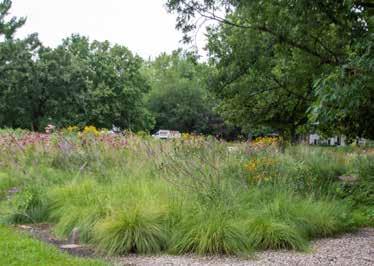
The Landscape Contractor May 2024 39
Drifts of Polemonium reptans and Phlox laphamii for spring interest
Sporobolus as edging
Focus — Native Design Aesthetics
SIMPLE COMBINATION FOR SUN
Latin Name
Common Name
Allium cernuum Nodding Wild Onion
Penstemon hirsutus Hairy Beardtongue
Rudbeckia fulgida Black Eyed Susan
Schizachyrium scoparium Little Bluestem
Sporobolus heterolepis Prairie Dropseed
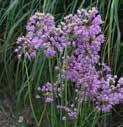
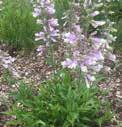
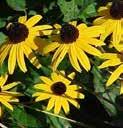


SEASONAL DRIFTING NATIVES FOR SUN
Latin Name
Common Name
Spring Dodecatheon meadia Shooting Star
Summer Echinacea pallida or purpurea Coneflower
Fall Symphyotrichum oblongifolium Aromatic Aster



SIMPLE COMBINATION FOR SHADE
Latin Name
Common Name
Asarum candense Canadian Ginger
Aquilegia canadensis Wild Columbine
Carex muskingumensis Palm sedge
Mertensia virginica Virginia Bluebells
Tiarella cordifolia Foamflower


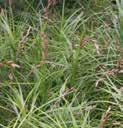


SEASONAL DRIFTING NATIVES FOR SHADE
Latin Name
Common Name
Spring Polemonium reptans Jacob’s Ladder
Summer Phlox divericata Woodland Phlox
Fall Symphyotrichum shortii Short’s Aster



40
The Landscape Contractor May 2024
Allium cernuum Penstemon hirsutus Rudbeckia fulgida
Schizachyrium scoparium Sporobolus heterolepis
Asarum candense Aquilegia canadensis Carex muskingumensis
Mertensia virginica Tiarella cordifolia
oblongifolium
Dodecatheon meadia Echinacea pallida Symphyotrichum
Polemonium reptans Phlox divericata
Symphyotrichum shortii
TALL NATIVES FOR SCULPTURAL EMPHASIS
Latin Name Common Name
Asclepias incarnata Rose Milkweed
Baptisia alba & B. australis White & Blue Wild Indigo
Eupatorium maculatum Joe Pye Weed
Hibiscus moscheutos Swamp Mallow
Ratibida pinnata Grey Coneflower
Silphium terebinthinaceaum Prairie Dock
Silphium laciniatum Compass Plant
Vernonia fasciculata Ironweed
Veronicastrum virginicum Culver’s Root

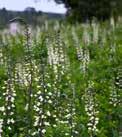

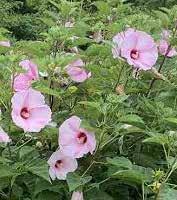
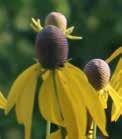
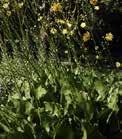
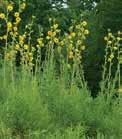
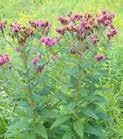
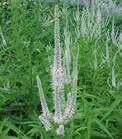


41 The Landscape Contractor May 2024
Hibiscus moscheutos
Asclepias incarnata Baptisia alba
Silphium terebinthinaceaum
Eupatorium maculatum
Silphium laciniatum
Veronicastrum virginicum Vernonia fasciculata
Ratibida pinnata
Koeleria macrantha, Carex rosea. Allium cernuum

Demanda de hierbas de estación cálida en primavera
by Krystal Flogel
Como cultivadores, siempre buscamos maneras de mejorar la producción y aumentar las ventas, ya sea afinando nuestros planes de producción para satisfacer mejor la demanda o ajustando nuestras prácticas de cultivo para reducir las mermas y mejorar la calidad de las plantas. Si queremos desarrollar al máximo nuestro potencial, necesitamos también identificar áreas de oportunidades perdidas. Pienso que podemos comprender esto, independientemente de nuestro papel en la industria. Lo contratistas de paisajismo ven oportunidades perdidas en los trabajos rechazados o retrasados debido a falta de mano de obra. La escasez de mano de obra ha sido también una de las principales causas de ventas perdidas para los centros de jardinería en los últimos años, no siendo posible para centros de jardinería independiente (IGN) faltos de personal descargar camiones, rellenar bancos y ayudar a los clientes.

En la producción de viveros, las oportunidades perdidas con frecuencia adquieren la forma de variedades de plantas, marcas o líneas de productos que no estamos cultivando. Pero también perdemos en ventas cuando no tenemos las plantas adecuadas listas en el momento adecuado. Algunas veces la solución es algo tan fácil como ajustar nuestro calendario de plantaciones, pero otras veces no es tan sencillo.
Entre los desafíos más grandes que los cultivadores enfrentan aquí en el Medio Oeste están las limitaciones ocasionadas por nuestra corta temporada de cultivo. El más reciente Mapa de Zonas de Rusticidad de las Plantas del Departamento de Agricultura de Estados Unidos (USDA), publicado este diciembre, nos proporcionó una cruda visualización de nuestro calentamiento climático – mostró la expansión de las zonas 6 y 7 por todo Illinois y la casi desaparición de la zona 3 en Wisconsin. Esencialmente, la mitad del país
pasó a una zona de rusticidad más caliente. Pero lo que el mapa no retrata es la creciente imprevisibilidad de eventos climáticos ocasionados por el cambio climático. Inviernos más suaves y primaveras más tempranas están dejando las plantas más susceptibles a daños por heladas de finales de primavera. Para un vivero como Mariani Plants, donde la mayor parte de nuestra producción se lleva a cabo al aire libre, rangos de crecimiento sin calefacción, la temporada de cultivo es solo de seis meses y las plantas que cultivamos usualmente se encuentran en la misma etapa de crecimiento que las de terrenos ajardinados. Este tipo de producción ofrece muchos beneficios, pero también presenta muchos desafíos. Por un lado, no todas las plantas están listas para su venta al detalle cuando los clientes están listos para comprarlas. La demanda primaveral de hierbas de estación cálida son un ejemplo perfecto de esto.
Algunas de nuestras hierbas ornamentales favoritas se clasifican como de estación cálida, incluyendo Panicum (pasto varilla), Miscanthus (hierba doncella), Hakonechloa (hierba Hakone), Andropogon (tallo azul gigante), Schizachyrium (hierba pie de pavo), Pennisetum (rabo de gato), Calamagrostis brachytricha (hierba de carrizo de pluma coreana) y Sporobolus (semilla de pradera), por nombrar solo algunas. Las hierbas de estación cálida no rompen la dormancia hasta finales de la primavera, florecen del verano al otoño, prosperan en temperaturas cálidas y no comienzan a crecer activamente hasta que las temperaturas del suelo y el aire alcanzan los 70 y 80 grados Fahrenheit, respectivamente. Por otra parte, las hierbas de estación fría usualmente florecen desde la primavera hasta comienzos del verano, crecen activamente en las temperaturas más frías de la primavera y el otoño y con frecuencia entran en dormancia o semi-dormancia a mitad del verano. Incluyen, Calamagrostis
42 The Landscape Contractor May 2024
x acutiflora (hierba de caña de plumas), festuca (fescue), Deschampsia (césped copetudo), Helictotrichon (hierba de avena azul) y Sesleria autumnalis (hierba de páramo de otoño).
Las diferencias entre hierbas de estación fría y de estación cálida son complejas y se originan a nivel molecular. Estos dos grupos de plantas también se clasifican como plantas C3 y C4 debido a las diferentes vías que utilizan para la fijación del carbono a través del proceso de fotosíntesis. La mayoría de las plantas en la Tierra, incluyendo las hierbas de estación fría, son plantas C3. Utilizan lo que nosotros usualmente consideramos el tipo de fotosíntesis más viejo y convencional que produce un compuesto de tres carbonos. Las hierbas de estación cálida utilizan la fotosíntesis C4, la cual es más eficiente que la fotosíntesis C3 y permite a las plantas retener más agua durante todo el día evitando la fotorrespiración. Estas diferencias son importantes porque nos ayudan a comprender por qué las hierbas de estación cálida han evolucionado para prosperar en ambientes cálidos y secos, y las hierbas de estación fría son más tolerante a las heladas y mejor adaptables a niveles bajos de luz y temperaturas más frías. Esto no solo explica por qué la festuca y el pasto varilla prosperan en diferentes épocas del año, sino que también nos ayuda a identificar las implicaciones más amplias relacionadas con la producción en viveros y el rol de las hierbas de estación cálida y de estación fría en terrenos ajardinados.
Debido a que crecen de forma tan diferente, adoptamos un enfoque muy diferente para las hierbas de estación cálida con respecto a las hierbas de estación fría en lo que respecta a nuestras prácticas de produc-
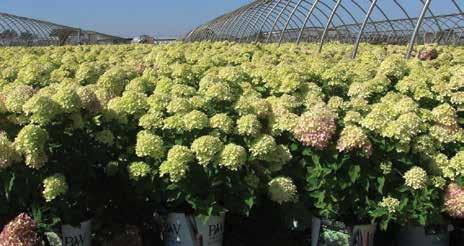
Mejores Plantas, Mejor Servicio Y Mejor Selección.

Mariani Plants se enorgullese en su attencion al cliente. Tenemos expertos ajentes de ventas de habla hispana en nuestras dos localidades, Kenosha Wisconsin y Garden Prairie Illinois. Mariani Plants esta aquí para proveerle mejores plantas, mejor servicio y mejor selección.
Llámenos a Mariani Plants: 866-627-4264 / marianiplants.com
TODOS JUNTOS MEJOR.

The Landscape Contractor 43 May 2024
ción. En primer lugar, podemos plantar en macetas la mayoría de las hierbas de estación fría, como Calamagrostis ‘Karl Foerster’, a finales del verano o comienzos de la primavera y fácilmente estarán listas a tiempo para las ventas de primavera. Pero las hierbas de estación cálida son otra cosa. Debemos colocar en maceta una Miscanthus o Panicum lo suficientemente temprano en el verano para dar tiempo a que se desarrollen las raíces antes de que lleguen las temperaturas más frías. Si las colocamos en macetas en primavera o en el otoño, el revestimiento permanecerá inactivo hasta que las temperaturas sean lo suficientemente calientes para permitir el crecimiento activo. Aunque las plantas estén bien enraizadas al entrar el otoño e hibernaron exitosamente, no es posible producir hierbas de estación cálidas listas para la venta en la primavera sin utilizar calor suplementario en nuestro clima. Si alguna vez ha dado mantenimiento al césped o jardín de un cliente, probablemente conocerá la dinámica de las hierbas de estación cálida y las de estación fría, especialmente en lo que respecta a controlar las malas hierbas. Las especies de estación cálida, como el césped salvaje, son particularmente competitivas porque prosperan durante las semanas cálidas y secas del verano, cuando las variedades de césped de estación fría con frecuencia permanecen dormantes. Debido a que la hierba curandera es una hierba perenne de estación fría, su ciclo de crecimiento anual se inicia a comienzos de la primavera, lo que le da una ventaja con respecto a plantas que nacen de semillas o emergen tardíamente. Se activa de nuevo en el otoño, después de que muchas de nuestras plantas ornamentales están dormantes o han sido cortadas. Sin duda, la maleza de estación cálida y la de estación fría se beneficia de sus ciclos de crecimiento opuestos, cada una de las cuales florece mientras la otra permanece en reposo. Podemos aplicar estos mismos principios en lo que se refiere a diseñar con hierbas ornamentales de estación cálida y de estación fría en un terreno ajardinado. Equilibrando su uso en el diseño, podemos ampliar la estación de interés y evitar las grandes brechas en el jardín cuando unas u otras están dormantes. Las hierbas de estación fría se pueden plantar estratégicamente frente a hierbas de estación cálida, debido a que proveen un impacto inmediato en la primavera y esconden las breves aglomeraciones dormantes. En la segunda mitad del verano, las hierbas de estación cálida estarán listas para desempeñar su papel mien-
tras nuestras variedades de estación fría reposan. Las hierbas de estación cálida y las de estación fría también han evolucionado para formar relaciones complementarias que benefician el ambiente en términos de control de la erosión, protección de la calidad del agua y la creación de hábitats silvestres. Las hierbas de estación fría proveen más beneficios de absorción de nutrientes en la primavera y el otoño cuando las hierbas de estación cálida están dormantes. En cambio, las hierbas de estación cálida desarrollan sistemas de raíces extensivos que pueden inmovilizar grandes cantidades de nutrientes excesivos durante los meses de verano. Este es solo un ejemplo de las complejas relaciones entre las plantas que encontramos en la naturaleza.

Habiendo dicho todo esto, sabemos que las demandas de los clientes no siempre están correlacionadas con el momento adecuado para plantar en el paisaje, especialmente en la primavera. No me malinterpreten, siempre deberemos tener dicentras floreciente disponibles en mayo, igual que siempre venderemos más Rudbeckia al mismo tiempo en que nuestra susana de ojos negros nativa está en flor a lo largo de las carreteras. Pero después de un sombrío invierno del Medio Oeste, los jardineros anhelan el color. No solo eso, sino que existimos en una economía bajo demanda en la cual los consumidores están acostumbrados a obtener lo que desean, cuando lo deseen. En una industria como la nuestra, en la cual no es inusual para los centros de jardinería generar más del 50% de sus ingresos durante el transcurso de un solo mes, debemos estar listos para arrancar a toda marcha cuando lleguen los primeros días cálidos de la primavera. Por mucho que queramos que las solicitudes de nuestros clientes se alineen con lo que se ve bien en el vivero en un momento específico, estamos, ante todo, en el negocio de vender plantas. Por eso cultivamos a pedido las plantas perennes cada primavera, utilizando iluminación y calor suplementarios, con el propósito de tener plantas florecientes, listas para la venta, disponibles a finales de abril cuando no es inusual que las temperaturas desciendas por debajo del punto de congelación. Pero es importante que continuemos educando a nuestros consumidores finales sobre temas como este; si comprenden cómo y por qué las plantas crecen como lo hacen, más probabilidades tendrán de tener éxito y eso nos beneficia a todos.
44 The Landscape Contractor May 2024
Para que crezca su negocio, unase a...

Servicios y Beneficios
• Certificaciones
• Seminarios
• Talleres de Trabajo
• Publicaciones
• Capacitación
• Videos
• Eventos
• Programa de Seguros
• Trabajadores Temporarios
• Subasta de Herramientas de jardinería
El Paso al Professionalismo. Llame al 630-472-2851 Para mas informacion sobre como inscribirse miembro. The Landscape Contractor 45 May 2024
Focus — Native Design Aesthetics
12 Native Plants to Know and Grow
by Heather Prince
As demand for native plants steadily increases, it’s important to have more selections in our plant palettes to meet the needs of clients. From passionate homeowners to concerned commercial property managers to municipalities and state entities, native plants are requested and required in many landscape designs. We spoke with Dave Neu, owner at NatureSpace LLC about some of his favorite picks in woody plants. Neu has more than 35 years of experience working with native plants and wildlife and is a resource for conservation restoration and management.
“In many cases, you can easily substitute native plants, for non-native selections,” recommended Neu. “There are
Five Fantastic Trees
Asimina triloba or Pawpaw
Zone: 5 to 9
Sun: full sun to part shade
Water: average to wet
Size: 15 to 25 feet high and wide
Bark: smooth grey
Flower: small deep-burgundy fleshy flowers in April
Fruit: plump yellow-green edible fruits that taste like banana custard
Fall Color: clear golden-yellow Substitute It For: Cornelian cherry dogwood, Persian ironwood, privet
Why We Love It: “The tropical leaves are very unique,” said Neu, “and the fruit is delicious.” Pawpaw has huge leaves that give it a layered, coarse texture unusual in the landscape. In optimum conditions it will slowly sucker, but typically is a single stem. You may have to guard against possums and racoons enjoying the fruit, but the battle will be worth it. Pawpaws are also larval hosts for pawpaw sphinx moths and zebra swallowtail butterflies.
so many options in natives that have the same or similar growth texture, or bloom time. Plus, there’s a native plant for just about every soil moisture gradient there is.”
While there are a bevy of native perennials to choose from, sometimes we overlook the broad array of trees and shrubs that grace our prairies, woods, and wetlands. Providing not only pretty flowers, these hardy species also support a wide range of wildlife, offer spectacular fall color, and can thrive in some tricky situations. “Perhaps the best selling point to clients is pollinators,” commented Neu. “I’m finding folks more and more interested in helping out our wildlife.”
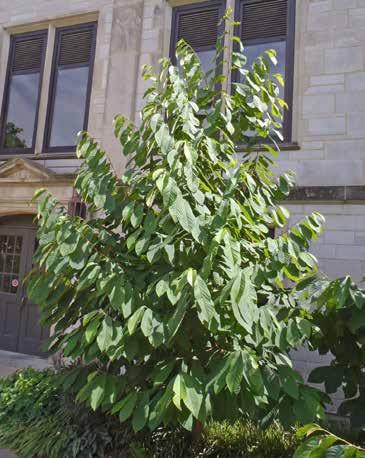
The Landscape Contractor May 2024 46


Focus — Native Design Aesthetics

Cornus alternifolia or Pagoda Dogwood
Zone: 3 to 7
Sun: full sun to part shade
Water: average to moist, well-drained
Size: 15 to 25 feet high; 20 to 30 feet wide
Bark: smooth brown
Flower: flattened cymes of creamy-white fragrant flowers in June
Fruit: deep-blue berries favored by birds
Fall Color: deep-red to magenta
Substitute It For: burning bush, Japanese maple, magnolia
Why We Love It: “I love their elegant shape,” reported Neu. “With open horizontal branching, pagoda dogwood is beautiful in flower and fall color.” Happiest as an understory tree, pagoda dogwoods are a statement specimen tree that develop their architecture with a little patience. Shorttongued bees seek out the flowers, including one specialist. Several moth species use it as a larval host as well as spring/ summer azure butterflies.
Carpinus caroliniana or Blue Beech, Musclewood, American Hornbeam
Zone: 3 to 9
Sun: full sun to full shade
Water: average to moist
Size: 25 to 35 feet high and wide
Bark: pale-grey elegant fluted smooth bark reminiscent of beech
Fruit: 3-inch papery winged nutlets resembling chandeliers that shatter and disappear in winter
Fall Color: orange to fiery-red
Substitute It For: Japanese tree lilac, crabapple, hedge maple, Newport plum
Why We Love It: Flexibility! This lovely understory native tree tolerates everything from full sun to full shade and wet to dry soils. Its rounded shape and horizontal branching habit can be limbed up or allowed to branch to the ground. “It’s slow growing, but the bark is distinctive,” commented Neu. The fiery fall color is also a plus. It is a larval host to several moths as well as tiger swallowtail butterflies. Songbirds devour the seeds.

48 The Landscape Contractor May 2024




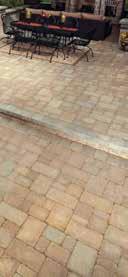

• Outcroppings and Boulders • Concrete & Clay Pavers • Retaining Walls • Ponds and Low Voltage Lighting • Seeds & Fertilizers • Mulch & Decorative Stone • Limestone Sills & Counter Tops • Bluestone - Nominal & Dimensional • Building Stone • Masonry Products 1300 Route 31 • South Elgin, IL 60177 (Corner of Route 31 & McLean Blvd.) 847-888-6133 • www.foxriverstone.com So the World Builds Better • Since 1934 DELIVERY AVAILABLE Supplying All Your Landscape Needs
Focus — Native Design Aesthetics
Quercus bicolor or swamp white oak
Zone: 3 to 8
Sun: full sun
Water: average to wet
Size: 50 to 60 feet high and wide
Bark: attractive flaky bark when young matures to deep fissures
Fruit: handsome small acorn
Fall Color: yellowish-brown, but leaves are marcescent and remain on the tree until spring
Substitute It For: Norway maple, littleleaf linden, Turkish filbert
Why We Love It: “They’re so versatile,” commented Neu. “I love that about them. The common name is really a misnomer as this oak tolerates drought as well as wet conditions. You can pretty much plant them anywhere as long as it’s sunny.” Swamp white oak is a fast-growing tree that can easily put on two feet a year. As with all oaks, it is a larval host of about 500 species of butterflies and moths.
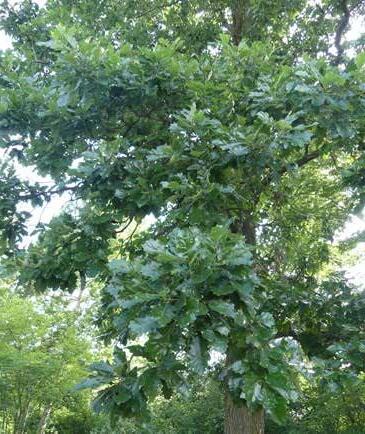



50 The Landscape Contractor May 2024
Not an ILCA Member? JOIN NOW for 2024! Call Marissa at 630-472-2851 for membership information. Get your career on the right path.
Tilia americana or American Linden, Basswood Zone: 2 to 8
Sun: full sun to part shade
Water: average to moist well-drained
Size: 50 to 80 feet high; 30 to 50 feet wide
Bark: pale in youth, becoming darker and more ridged with age
Flower: clusters of creamy-yellow deeply fragrant flowers in June
Fruit: small nutlets attached to bracts
Fall Color: yellow
Substitute It For: Littleleaf linden, Norway maple, ornamental pear
Why We Love It: This fast-growing large native linden will tolerate drought and clay soil. “The fragrance in bloom is fantastic,” said Neu. “You’ll have every bee in the neighborhood.” Linden honey is a prized delicacy and the flowers have also been used for tea.
Distinctly pyramidal in shape, American linden is the larval host to a long list of moths.

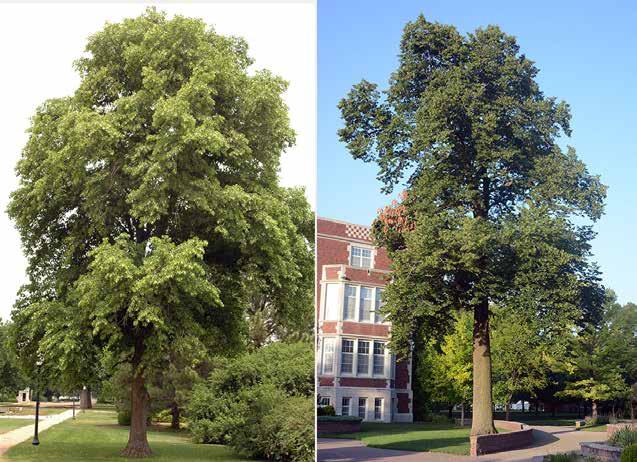
An Incred I ble Select I on With Infinite Po S s I b I l I t I e S . Revel in an infinite selection of over 15,000 trees, 35,000 shrubs, 100,000 perennials, and 500 varieties at our 650-acre farm.

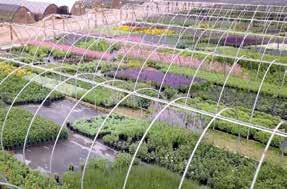
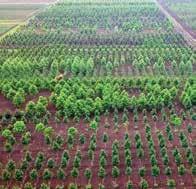
Little Rock Farm 2353 Creek Road · Plano, IL 60545 630-552-8314 Main Office & Sales Yard 7200 S. Madison · Willowbrook, IL 60527 630-323-1411
Over 11 acres of holding yard in two convenient locations. For sale updates and availabilities, sign up for our email newsletter. Trees, Ornamentals, Evergreens, Shrubs, Annuals, Perennials, Vines, and Groundcover.
The Landscape Contractor 51 May 2024
HinsdaleNurseries.com
HN_007_ILCA_7.375x4.8125.indd 1 11/14/22 10:31 AM
Focus — Native Design Aesthetics
Seven Spectacular Shrubs
Cephalanthus occidentalis or Buttonbush
Zone: 5 to 9
Sun: full sun to part shade
Water: moist to wet
Size: 5 to 10 feet high; 4 to 7 feet wide
Flower: round fragrant white flowers bloom in June
Fruit: flowers mature into attractive reddish nutlets favored by birds
Substitute It For: dogwood, willow, privet
Why We Love It: Buttonbush is happiest with wet feet, making it a great option for rain gardens, swales, and that pesky damp corner. It’s also a top-notch pollinator attractor. “In flower, it’s covered with tiny bees, syrphid flies, wasps, just everything,” observed Neu. It’s also the larval host for buttonbush sphinx moths.

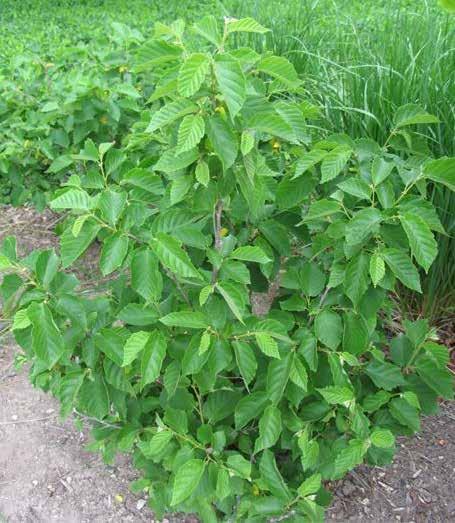
Corylus americana or American Hazelnut
Zone: 4 to 9
Sun: full sun to part shade
Water: average to moist
Size: 8 to 10 feet high and suckering
Flower: elegant pendulous greenish-yellow catkins in early spring
Fruit: small, tasty edible nuts encased in leafy bracts
Fall Color: shades of yellow, orange, and peach
Substitute It For: burning bush, privet, hedge cotoneaster
Why We Love It: “It can be a wonderful hedge,” commented Neu. “The fall color is beautiful and maybe someday I’ll beat the squirrels to the nuts.” American hazelnut is a robust suckering shrub that can quickly fill a space. It thrives with shearing and renewal pruning for those seeking a more formal appearance. The early spring catkins are decorative, but the fall color with a kaleidoscope of yellow and orange makes this plant worth including in a plan. It’s also a larval host for a long list of moths.
52 The Landscape Contractor May 2024
Diervilla lonicera or Bush Honeysuckle Zone: 3 to 7
Sun: full sun to part shade, tolerates full shade
Water: average to drought tolerant
Size: 3 to 4 feet high and wide
Flower: pretty clusters of sulfur-yellow flowers in July through August
Fall Color: shades of red to orange to burgundy
Substitute It For: burning bush, barberry, Japanese spirea
Why We Love It: “The bees and pollinators love the flowers,” said Neu. “The shrubs will arch over and knit together at around 4 feet, giving you a beautiful mass. They’re incredibly tough. I’ve seen them happy in sand to clay and everything in between.” Diervilla is a beautiful workhorse for dry shade that gives you lovely fall color and flowers. Plus, it’s a larval host to snowberry clearwing and gray scoopwing moths.
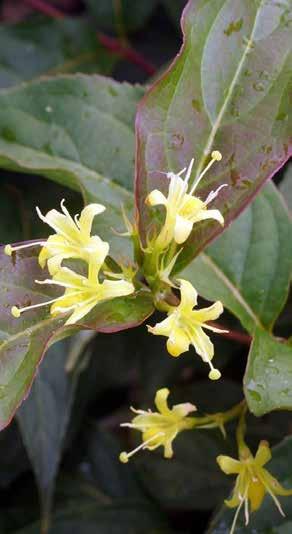









The F.A. Bartlett Tree Expert Company Call 877-227-8358 or visit bartlett.com PRUNING | FERTILIZATION | CABLING & BRACING INSECT & DISEASE MANAGEMENT | TREE INVENTORIES STORM DAMAGE | LIGHTNING PROTECTION | REMOVALS EXPERT TREE CARE FOR 115 YEARS — AND GROWING. For 115 years, our family-owned company has brought a rare mix of groundbreaking science, award-winning safety practices, and global resources to every tree and shrub care task at hand. And at the heart of our success are our people — experts who know and champion every tree, no matter the species. Discover how our passion is inspiring one beautiful property after another. WE’RE FOR EVERY TREE. WE’RE FOR EVERY TREE. Northbrook - Bolingbrook - Lake Barrington - Chicago The Landscape Contractor 53 May 2024
Focus — Native Design Aesthetics
Hypericum kalmianum or Kalm’s St. John’s Wort
Zone: 4 to 7
Sun: full sun to part shade
Water: average to wet
Size: 2 to 3 feet high and wide
Flower: brilliant yellow pompom flowers in July through August beloved by bees
Fruit: mahogany capsules that persist over the winter
Fall Color: shades of red and mahogany
Substitute It For: Japanese spirea, barberry, weigela
Why We Love It: With bright sunny flowers and short stature, St. John’s wort is a pretty native addition to beds and foundation plantings. “It’s so underutilized,” commented Neu. “It fits in small spaces and is very adaptable to soils, particularly moist ones.” It is the larval host to gray half-spot, common pug, and wavy-lined emerald moths.


Lindera benzoin or Spicebush
Zone: 4 to 9
Sun: full sun to part shade
Water: average to moist, well-drained
Size: 6 to 8 feet high and wide
Flower: small clusters of fragrant lemon-yellow flowers in March or April
Fruit: bright red berries enjoyed by birds
Fall Color: golden yellow
Substitute It For: hedge cotoneaster, burning bush, Cornelian cherry dogwood
Why We Love It: Spicebush can be a good alternative for viburnum for those dealing with viburnum leaf beetle. It also heralds spring with its fragrant small flowers. “Every plant part is fragrant when crushed,” reported Neu. “It’s adaptable and if you plant more than one, you’ll get the nice red berries birds love.” Spicebush is the larval host for spicebush swallowtail butterfly as well as promethea and tulip tree beauty moths.
54 The Landscape Contractor May 2024

Viburnum prunifolium or blackhaw viburnum
Zone: 3 to 9
Sun: full sun to full shade
Water: average to dry
Size: 12 to 15 feet high; 6 to 12 feet wide
Flower: flat white flower clusters in May beloved by pollinators
Fruit: dark blue berry-like drupes enjoyed by wildlife
Fall Color: red-burgundy
Substitute It For: burning bush, lilac, kousa dogwood
Why We Love It: Blackhaw viburnum is flexible. From sun to shade, average to dry soils, this large shrub handles it all. “It gets big, but you can prune it for a hedge or train it into a small tree,” said Neu. “It’s fall color is really outstanding.” More resistant to viburnum leaf beetle than arrowwood, blackhaw also features dark blue berries or haws that attract birds. Like all the native viburnums, it’s a larval host to spring/summer azure butterflies and a long list of moths.
Sambucus canadensis or Elderberry
Zone: 3 to 9
Sun: full sun to part shade
Water: average to wet
Size: 5 to 10 feet high and wide, sometimes suckering
Bark: clean brown with lenticels
Flower: huge 10-inch flat white flowers in June beloved by pollinators
Fruit: large clusters of black edible berries
Fall Color: yellow
Substitute It For: privet, burning bush, hedge cotoneaster
Why We Love It: If you need a large, fast-growing shrub for screening, elderberry is a candidate. The reward is prolific berries. “I made syrup from mine last year,” commented Neu. “The berries are so good for you! Plus, the small pollinators seek out the huge flowers.” Elderberry also tolerates wet feet and can be perfect for a wet corner to anchor a design.

55 The Landscape Contractor May 2024
Frese Ornamental Nursery and Landscaping
3100 N. 18th Street
Quincy, IL 62305
(217) 222-0977
www.freseornamentalnursery.com

 by Meta L. Levin
by Meta L. Levin
Frese Ornamental Nursery and Landscaping customers know where to head when they visit the facility: they follow their noses to the homemade cookies baked by Sarah Genenbacher, who, with her husband, Ted, and their three sons, are the seventh generation to own the Quincy, IL based and family-owned and operated business.
The company has been a family business since its inception in the late 19th century. Originally Forest Oak Nursery founded by Louis Frese, a German immigrant, it has gone through several iterations. In 1927 it moved to its present location as Edward J. Frese Nursery, specializing in fruit trees and berries.
By 1959 Edward Frese’s sons, Richard and Gerald took over, renaming it Frese Brothers Nursery, establishing a small retail yard and adding other crops, such as evergreen trees and shrubs, flowering shrubs, as well as strawberries and other berries.
In 1986 Mike Maas and Fred Landsing, owners of Ornamental Landscaping joined with Clint Frese to buy the company, giving it its current name: Frese Ornamental Nursery
and Landscaping. Landsing sold his portion to Maas and Frese in 1999. Then, in 2008 Frese sold to the Maas family and, in 2018, Maas’ daughter and son-in-law, Sarah and Ted Genenbacher took over. Katie Ipensen, Maas’ other daughter, still works there.
Sarah Genenbacher and her sister, Katie, grew up working side by side in the fields. Sarah Genenbacher’s husband, Ted, was raised on a farm, did some construction and has worked in the Frese business since 1989. “I loved being outside,” he says. “I knew I wanted a career that let me work outdoors. Now I do a lot of paperwork!”
The Genenbacher’s three sons make the seventh generation working in the business. Tad Genenbacher is a grower, who also runs the wholesale division; Brad is a landscape installer and works in the field and Andrew is also with the landscape division. Their children help out by watering plants on the weekends, setting the stage for the eighth generation at Frese Ornamental Nursery and Landscaping.
Even the employees are considered family, which may be the reason that some have been with the company for years.

56 The Landscape Contractor May 2024
Member Profile Snapshot

Nicole Sill is the retail manager. She started in high school and has worked for Frese Ornamental Nursery and Landscaping for 17 years. “She knows everything that is going on,” says Sarah Genenbacher. “She is very hands on.”

Skip Schoonover is a 40-year veteran. A member of the land scaping crew, he is knowledgeable and good at training other workers in the right way to perform tasks. “You can’t replace people like that,” says Ted Genenbacher.
Katie Ippensen is Sarah Genenbacher’s sister. She handles the books, is involved in the wholesale division and helps in the retail end.
The family has expanded the landscaping and garden center portions of the business, but continues to focus on the nursery and its trees and shrubs. “We do it right,” says Ted Genenbacher. “We do work that no one else wants to do and we tell our guys that no matter what, they are to go the extra mile.” His wife echoes his pride. “We have fabulous customer service and a knowledgeable staff,” she says.

They have 60 acres of nursery stock, but, she says, “landscaping is the biggest side of our business.”
The company also offers outdoor lighting, hardscapes and sidewalks.
Frese Ornamental Nursery and Landscaping began as IGIA members early on and now are members of ILCA. “It helps us keep connected to the industry and what is going on,” she says. Her husband points to the knowledge of new plant material and an ability to “stay on the front edge.” They are pleased with efforts now being made to host events in their region.
And the cookies? Chocolate Chip Toffee are by far the customers favorite, followed by lemon.

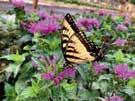

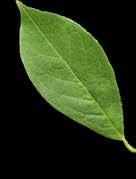
57
Midwest’s premier nursery growing since 1985. 500+ quality cultivars of shade, ornamental, & evergreen trees as well as container plants. www.goodmarknurseries.com Growing for your success. PERENNIALS CONTAINER SHRUBS DELIVERY AVAILABLE Coneflower, Allium, Daylily, Catmint, Dianthus, Heuchera, Grasses, Hostas & MORE. Quality grown mix of Hydrangea, Boxwood, Dogwood, Chokeberry, Lilac, Viburnum, & MORE. 8920 Howe Road Wonder Lake, IL (815) 653-9293 XL ABOVE GROUND YARD Delivery to your yard or jobsite! The Landscape Contractor May 2024
Classified Ads
Landscape Estimator
At Seasonal Landscape Solutions, we don’t just deal in landscaping; we craft outdoor dreams, specializing in residential designbuild landscaping. Our passion lies in transforming spaces into captivating havens for both residential homeowners and commercial clients. We are a full-service design, installation, and maintenance company, that is family-owned, located in Algonquin, IL servicing the Northwest Chicago suburbs.
We are currently seeking a detail-oriented person who has a passion for producing accurate estimates that will set a project up for success. You could be the right fit for our Estimator position if you are:
*Detail-oriented and highly accurate
*Responsible and disciplined, able to prioritize and achieve deadlines
*Process-driven, thinks with logic and order in their work
*Accountable for their actions as part of a team You may be our estimator if you are forwardthinking and have a passion for continuous improvement, and a knack for working with numbers. This position would own the estimating system (LMN) and be responsible for timely and accurate estimates. You would also be responsible for keeping the system organized and updated as needed. The ideal candidate would facilitate the flow of information from sales to production, bringing clarity and structure to the project. You would also participate in weekly team meetings and provide input or suggestions.
Responsibilities:
*Read and interpret drawings and specifications, perform take-offs as needed
*Develop accurate estimates and proposals
with attention to detail, estimating projects at or above the target margin
*Negotiate with vendors, purchasing agents, and buyers of materials for pricing
*Review job costing with the accounting team
Benefits:
*Health
*Dental
*Paid Time Off
Salary Range:
Generous Compensation Based on Experience
Schedule:
*M-F Day Shift
Preferred Experience:
*LMN 2 years (Prefer) or Other Estimating
Platform
*Microsoft Office Suite
*Construction Estimating 3-5 years (Prefered)
How to apply: Please forward your resume to tracy@seasonallandscape.com or call 224383-4335
ANNUAL SALES TEAM LEAD
The Growing Place in Naperville is looking for a strong, fast, and organized individual to lead the retail staff, help with customer interactions, stocking, and care of plants. Applicants should have experience leading people and be excited about plants. Collaboration with other teams and leaders will be frequent and encouraged. This is a full-time position with possibilities to be year-round or seasonal.
How to apply: Visit https://thegrowingplace. isolvedhire.com
Designer
Designer with degree: no experience necessary, will train. Meet with clients, present quotes, and set up jobs with crew.
A drivers license is a must. Pay negotiable. How to apply: michelle4seasons@yahoo.com
King’s Landscape Design is Hiring : Design Sales and Maintenance Account Management
King’s has been a staple in the western suburbs for over 50 years.
We are in need of a Sales / Design individual and a Maintenance Account Manager. Both positions are salaried and will be commiserate with experience and education. We offer 401K and health insurance. The ideal candidates will be energetic, gregarious, and self-driven.
Design / architectural experience or education would be a plus for the sales position. A horticulture background, or degree, would be ideal for the maintenance account manager. We appreciate all inquiries.
How to apply: Please direct questions and resumes to mking@kingslandscaping.com
Turn-Key Landscape Facility For LeaseHampshire, IL
Furnished Office, Shop, and 3 Acres of Lighted Yard Area For Lease.
Suitable for Landscape Contractors with all the Amenities at this Turn-Key Facility.
Contact Adam Neisendorf for detailed information.
Email: aneisendorf@ploteproperties.com or Phone: (847) 428-1000 ext. 228
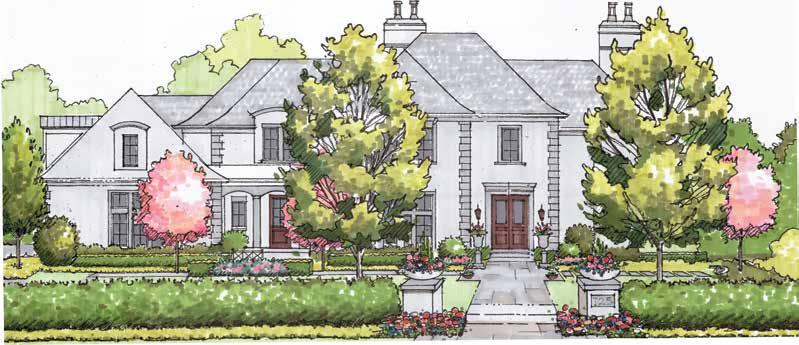
OPEN POSITIONS: Account Manager
Bookkeeper jamesmartinassociates.com | (847) 634-1660 lidlandscapes.com | (303) 440-7833
58 The Landscape Contractor May 2024 HELP
HELP
HELP WANTED
WANTED
WANTED






59 The Landscape Contractor May 2024 Our people are the bottom line SEE OUR CURRENT OPENINGS
Classified Ads
Garden Center Sales Associate – Seasonal We are seeking hardworking, trustworthy, and dependable individuals to add to our retail garden center team.
Responsibilities include:
Welcome and assist customers to best identify their needs.
Enter and process customer transactions. Unload trucks when new stock arrives. Heavy lifting may be required to move carts of plant material.
Price and label plant material accurately and accordingly.
Water and maintain current stock to ensure the highest quality of plants.
Set up displays and assist with seasonal décor.
Maintaining grounds, weeding, watering, pruning, cleaning fountains, merchandising.
How to apply: Email info@fieldsnursery. com or call 815-744-7841
CLASSIFIED ADS CLOSING DATES & RATES
June 2024 issue ads: May 15, 2024 July 2024 issue ads: June 14, 2024
PLEASE NOTE:
“HELP WANTED” AD SALES ARE LIMITED TO ILCA MEMBER COMPANIES
Website
PLEASE NOTE:
“HELP WANTED” AD SALES ARE LIMITED TO ILCA MEMBER COMPANIES Submit your ads online at ilca.net




• Sales and marketing statistics

•





60
Magazine Cost is $5 per line Minimum charge $50
your ads online at ilca.net
Call Alycia Nagy
472-2851 The Landscape Contractor May 2024 Successful suppliers know— industry leaders read this magazine. Save the Date — Aug. 10, 2017 May.17_TLC.indd Save the Date — Aug. 10, 2017
Cost is $12 per line Minimum charge $120 (About 6 words/line) Submit
or
(630)
the single best
buyers is through highly-targeted
show that
way to reach
specialty magazines.
This award-winning magazine is frequently hailed as the best magazine of its kind. Put your ad message in this very flattering environment.
The Landscape Contractor has an affordable advertising program for every budget. For immediate attention CALL Debbie at 817-501-2403 or email — debbie.landscapecontractor@yahoo.com
•
HELP
HELP WANTED
HELP WANTED
WANTED
Inspiration Alley
Editor’s Note: Over time, we run across a mountain of fun, innovative, and generally creative ideas. They don’t always fit with the magazine content, but we do collect them for some future use. This brings us to Inspiration Alley, a place where we display pure creativity. It’s up to you to judge the merit of each offering. So use it, lose it or be inspired to try something different.
Add Some Bubbly
By Nina A. Koziol
A water feature can be subtle, elegant, charming or whimsical. Add a little bubbly — a cascading bowl, an urn or a wall-mounted fountain—to your client’s front entry or on a patio, a deck or in a nearby border. Splash a little life into your next project.



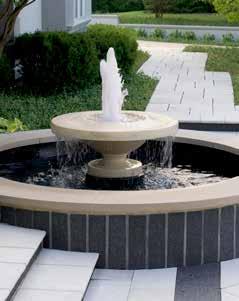
Bartlett Tree Experts .................................................53 Cedar Path Nurseries .................................................27 Dayton Bag and Burlap ...............................................50 Doty Nurseries LLC ..................................................4 Goodmark Nurseries ................................................57 Green Glen Nursery ..................................................63 Hinsdale Nurseries, Inc. ..........................................51 Holcim Fox River Stone ............................................49 Homer Industries .......................................................15 IDES ...........................................................................28 James Martin Associates ..........................................58 JKS Ventures ............................................................53 Longshadow Planters ..................................................13 Mariani Plants .............................................................6 Mariani Plants ............................................................43 McGinty Bros. ...........................................................41 Midwest Groundcovers ................................................2 Midwest Trading ........................................................29 Premier .......................................................................59 Rocks Etc. ................................................................21 Spring Meadow Nursery ............................................19 Star Roses .............................................................17, 37 Straughn Farms ..........................................................47 The Mulch Center .....................................................25 Unilock, Inc. ...............................................................64 Wilson Nursery and Landscape Supply .......................20 Xylem Ltd ................................................................21 61 The Landscape Contractor May 2024
Advertisers
A shallow bowl with bubbler attracts birds.
A fountain off the deck adds relaxing water “music” at night.
This fountain features a contemporary vibe by Hursthouse, Inc.
Mary Allen of Plandscape created an entryway for relaxation.
Yucca ‘Color Guard’ for Year-Round Impact
By Mark Dwyer
Our landscape designs address beauty and function as plant materials transition and guide interest through a progression of bloom, colorful foliage, seasonal transitions and thoughtful accents. However, when we consider our plant palette, how many selections have the merit and pizzazz to offer colorful interest every day of the year? I can’t name many but one that always comes to mind is the variegated ‘Color Guard’ yucca (Yucca filamentosa, z 4-10). I’ve suggested this plant in so many designs that I might qualify to be the national spokesmodel for this dramatic, architectural and colorful plant.
Truly not an herbaceous perennial, although it is frequently sold as such, this plant (Agavaceae family) is referred to as a shrub or broadleaf evergreen which invites some confusion in our climate. Regardless, the rosettes of spear-shaped, evergreen leaves feature prominent, rich, creamy yellow bands down the center of every strappy leaf. Additionally, the leaves have curly filaments appearing as “white threads” along the edges. Basal offsets will slowly create an expanding, rigid, V-shaped clump that reaches 36” in height and width in time.
Commonly called Adam’s needle or Spanish bayonette, this yucca species (the straight species is green…and larger) has a broad native range in central and eastern North America. While there are other variegated forms (‘Variegata’, ‘Bright Edge’ and ‘Golden Sword’), this selection is my favorite and likely the most commonly available. When sunlight catches the yellow patterns in ‘Color Guard’, the plant truly glows.
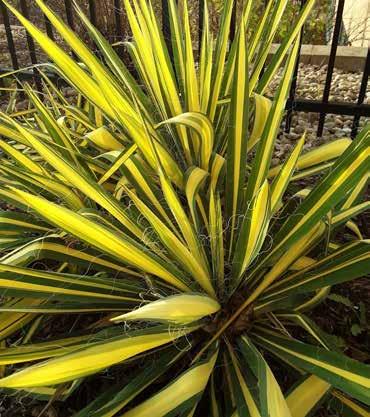
The golden leaf centers also get tinges of pink, rose and coral during the winter months with new growth regenerating in spring. Flowering, while dramatic, is not typically an annual event. Do be prepared, however, for a 5-6’ flowering stalk with panicles of pendulous, fragrant, creamy white, bellshaped flowers (2-3” long each!) that are wonderful for hummingbirds, butterflies and moths.
Preferring full sun, Adam’s needle will tolerate average to poor soils but does need decent drainage. ‘Color Guard’ yucca is drought, heat, cold, wind, clay, salt, walnut and humidity tolerant which is a long list! Deer and rabbits are also quite uninterested in snacking. This yucca does develop thick, deep, fleshy roots which make it challenging to move and transplant mature specimens. Be sure to wear protective gloves when handllng this plant and goggles aren’t a bad idea either.
The rigid, sword-shaped, spine-tipped foliage offers a real pop of color and distinctive presence in the garden. The side foliage is slightly arching but no less colorful. This reliably colorful plant gives a sunny, “starburst” blast of color when used in the garden and landscape. ‘Color Guard’ is an amazing sculptural accent as a specimen plant but also is potently beautiful in groupings, containers, the rock garden or xeriscape. This variety also received an Award of Garden Merit from the Royal Horticultural Society (RHS) in 2012. How often do we run across a hardy, trouble-free and long-lived plant for our landscapes that catches the eye every day of the year!?

Before You Go —
62 The Landscape Contractor May 2024

THE ONE LEADER IN PAVERS & WALLS
In the hardscaping industry, Unilock is the ONE.
Experience the remarkable colorfastness of Unilock EnduraColor™ . Our two-step manufacturing process combines special aggregates and concentrated color toward the top, resulting in a refined surface that resists fading over time.
With the broadest selection of products, styles, and finishes available, our comprehensive range ensures that we have the perfect solution for every type of project.







Choose Unilock, the ONE partner who gets you the most. Learn more


 Bloom Time
Bloom Time




















 Scott Grams, Executive Director April 17, 2024
Scott Grams, Executive Director April 17, 2024

















































































































































































 by Meta L. Levin
by Meta L. Levin






























